Samosa Recipe (Better Than Takeout)
Samosa is a crispy, golden-fried North Indian snack with a flaky pastry shell filled with a savory, spiced, tangy mixture of mashed potatoes, green peas, and aromatic spices. This iconic street food is often served hot with sweet tamarind and spicy green chutneys, making it a beloved tea-time treat across Delhi, Punjab, and beyond.
Punjabi Samosa – A Crispy, Spiced Classic
A samosa is a deep-fried Indian snack with a crisp, flaky crust and a savory filling –usually spiced potatoes and peas. Flaky and crunchy, samosas are among the most beloved street food snacks in North Indian cuisine.
They have a pastry-like shell and a comforting, spiced potato and green peas stuffing that makes them incredibly satisfying.
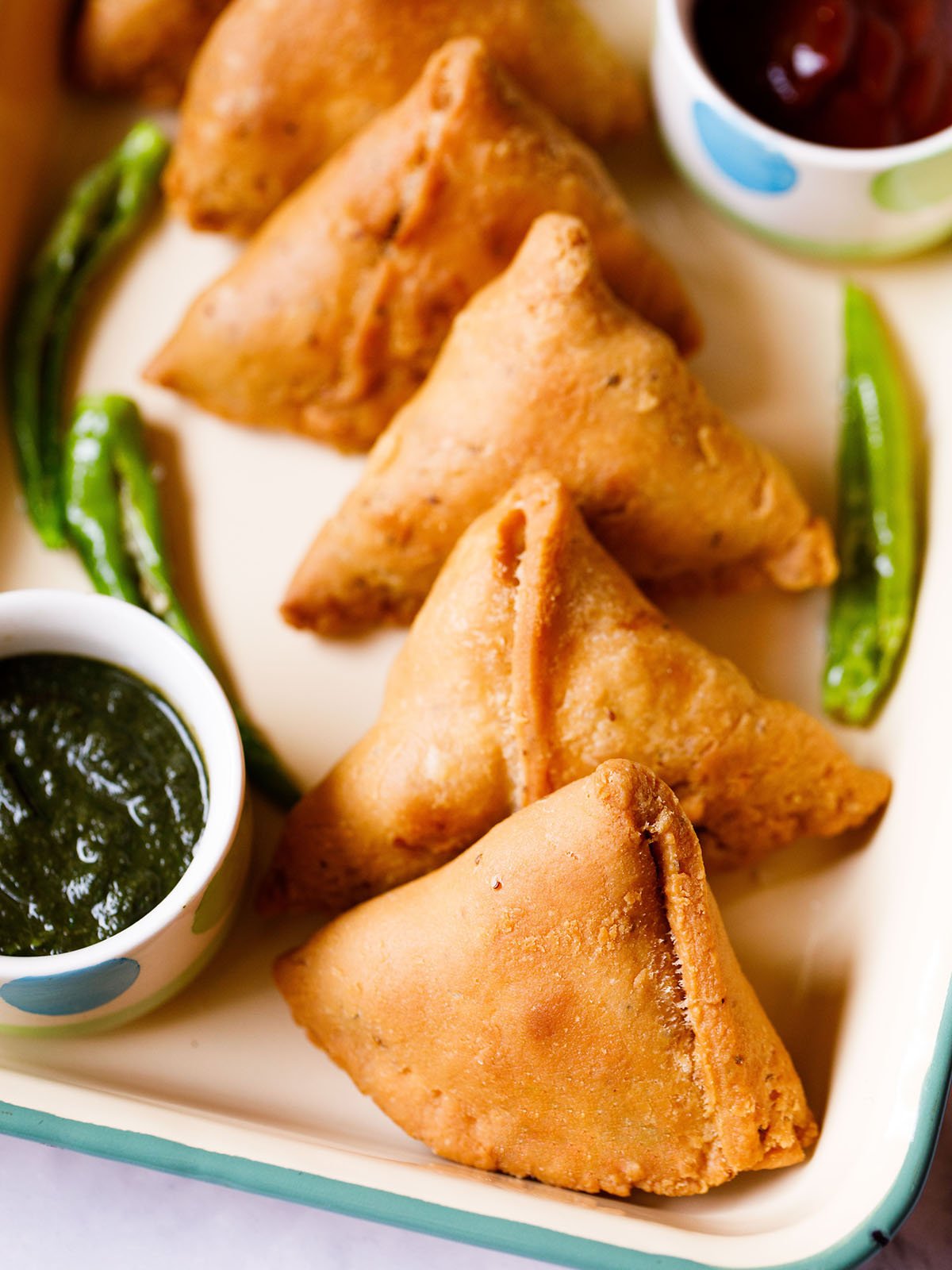
What makes this the best homemade samosa recipe? As a trained pastry chef who’s worked with everything from laminated doughs to shortcrusts, I can tell you –achieving that golden, flaky crust comes down to the right balance of fat and water.
Table of Contents
In this recipe, I use slightly less water than usual to create a firmer, flakier dough. This is the same trick I use when making samosa pie – a baked, non-fried version that’s just as delicious.
The filling is hearty, gently spiced, and easy to prepare in a pressure cooker, Instant Pot, or stovetop pan. It’s based on a version from my old cooking school notes and has become a favorite at home.
You’ll find a video included that shows exactly how I shape, fill, and fry the samosas; perfect if you’re making them for the first time and need a visual reference.
Crispy on the outside, soft and spiced within—this step-by-step guide will help you master the art of making authentic Punjabi samosas from scratch.
Step-by-Step Punjabi Samosa Recipe
Below is my complete step-by-step guide with photos for making the best Punjabi Samosa recipe from scratch.
You start by making the savory filling and pastry dough. Then assemble the Aloo Samosa, fry, and enjoy with your favorite dipping sauces and chutneys!
Boil Potatoes & Cook Peas
1. The first step is to cook the potatoes and peas for the savory and spiced filling.
- To cook the potatoes and peas in a stovetop pressure cooker: Place 3 medium-sized whole potatoes (300 to 450 grams) and 2 to 2.5 cups water in a 3 or 4 litre pressure cooker. On top of the potatoes carefully set a small trivet and pressure cooker-safe bowl with ½ cup green peas. Pressure cook for 5 to 6 whistles or 7 to 8 minutes on medium to medium-high flame.
- If using an Instant Pot: Place 3 medium-sized whole potatoes in the steel insert of a 6 quart IP. Add 2 cups water. Place a trivet on top of the potatoes, and on top of the trivet set a bowl with ½ cup of green peas. Pressure cook on high for 20 to 25 minutes.
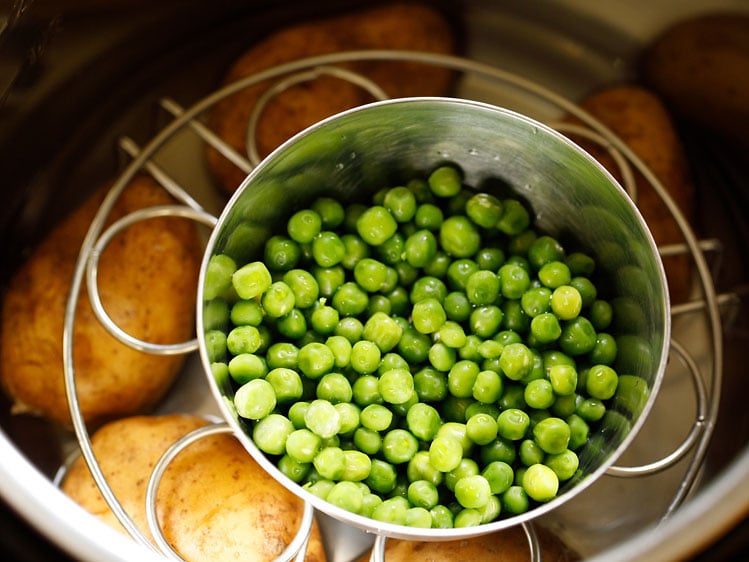
2. For the stovetop pressure cooker, remove the lid after all the pressure falls in the cooker.
For the Instant Pot, do a quick pressure release after 5 to 7 minutes. Check with a knife or fork to see if the potatoes are cooked well.
The knife or fork should be able to slide through easily if the potatoes are cooked properly.
If the potatoes are undercooked, then cook them for a few more minutes using the pressure cook function. Once done, drain the potatoes and peas in a colander and set aside to cool.
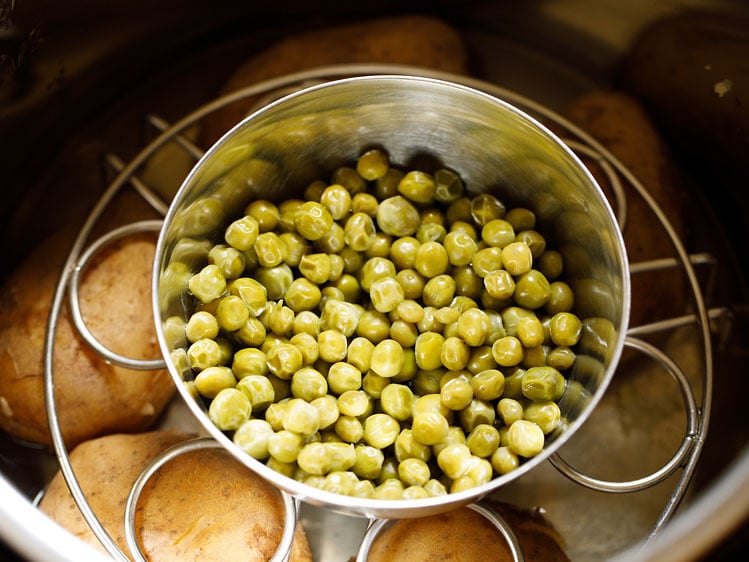
Lightly Toast & Crush The Whole Spices
3. Next, roast or toast the spices. This will help to release their flavors and should not be skipped!
To a small frying pan over low heat add the following spices:
- ½ inch cinnamon stick
- 1 clove, optional
- 1 green cardamom
- 3 black peppercorns
- ½ teaspoon cumin seeds
- ½ teaspoon fennel seeds
- 2 teaspoons coriander seeds
Heat the spices for just a few minutes until aromatic, being careful to not burn.
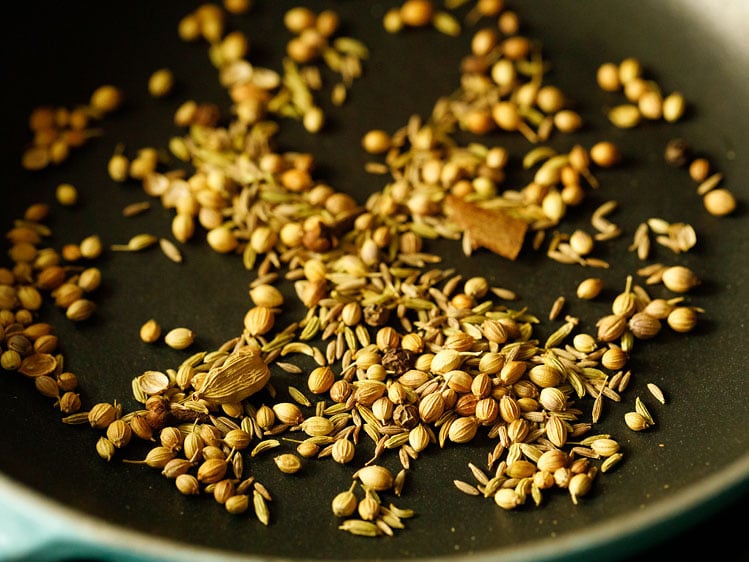
4. Remove the spices from the heat and allow to cool completely. Then, put them in a spice grinder or small mixer-grinder jar.
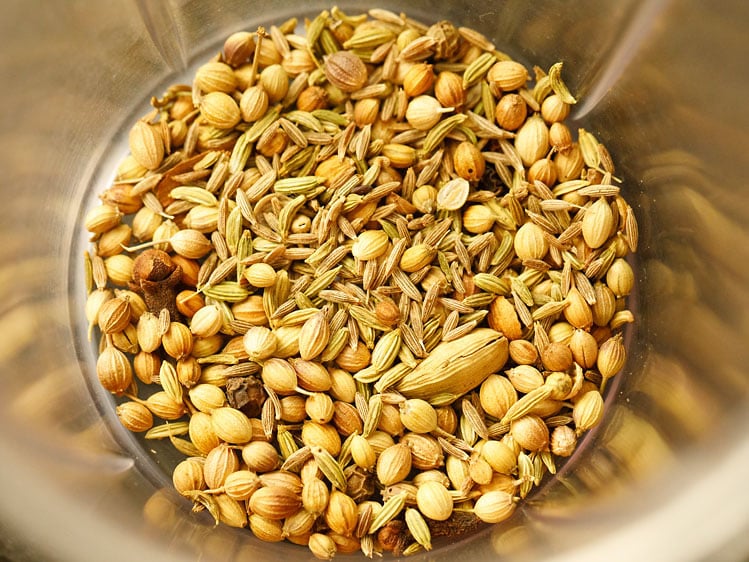
5. Grind the toasted spices to a semi-fine powder, and set aside.
In a Hurry? Use This Quick Spice Blend Instead
Mix together:
- 2 teaspoons coriander powder
- ½ teaspoon cumin powder
- ½ teaspoon fennel powder
- ½ teaspoon garam masala
Add this spice blend in step 9, along with the green peas and other ground spices.
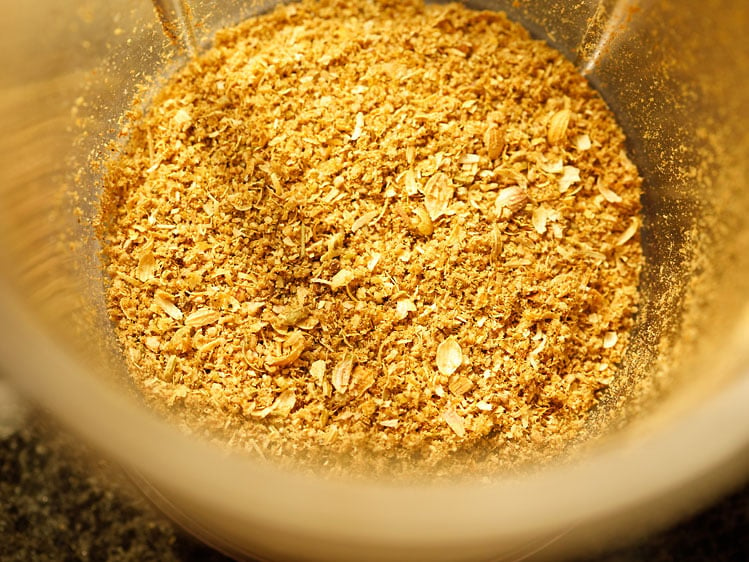
Make The Tangy-Spiced Potato Stuffing
6. Peel the skin off of the cooked potatoes, and chop them in ½ to 1 inch cubes.
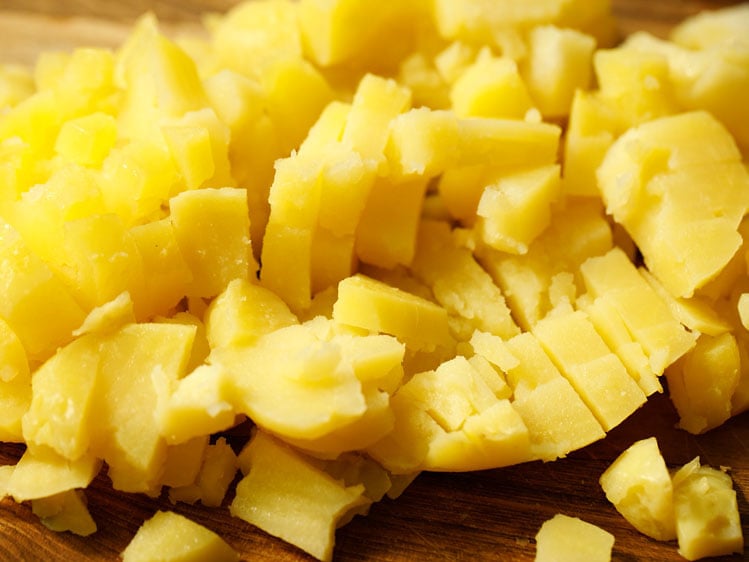
7. In a small skillet, heat 1 tablespoon oil. When the oil becomes medium hot then reduce the heat to low.
Crackle ½ teaspoon cumin seeds until fragrant. I used mustard oil as it really adds a punch in the stuffing.
You can use neutral oil like sunflower oil, safflower oil, grapeseed oil or canola oil.
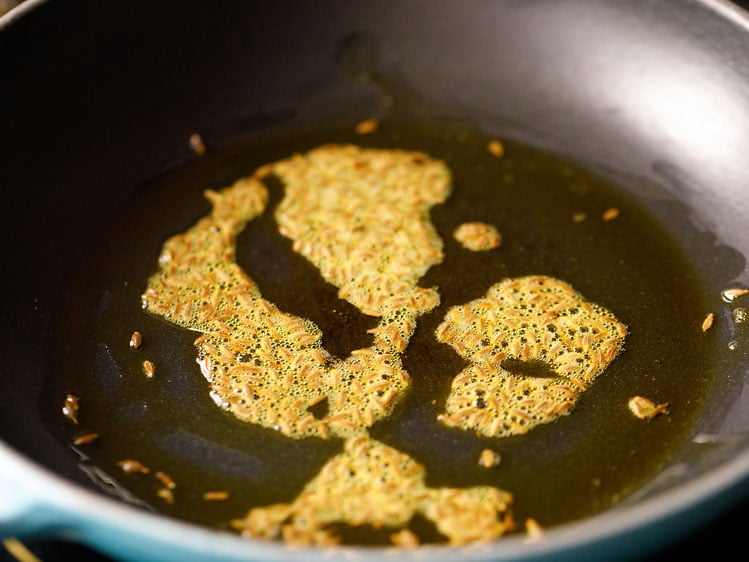
8. Keep the heat on low and add 1 teaspoon finely chopped or minced ginger and 2 teaspoons finely chopped green chillies.
Sauté for a few seconds until the raw aroma of ginger goes away.
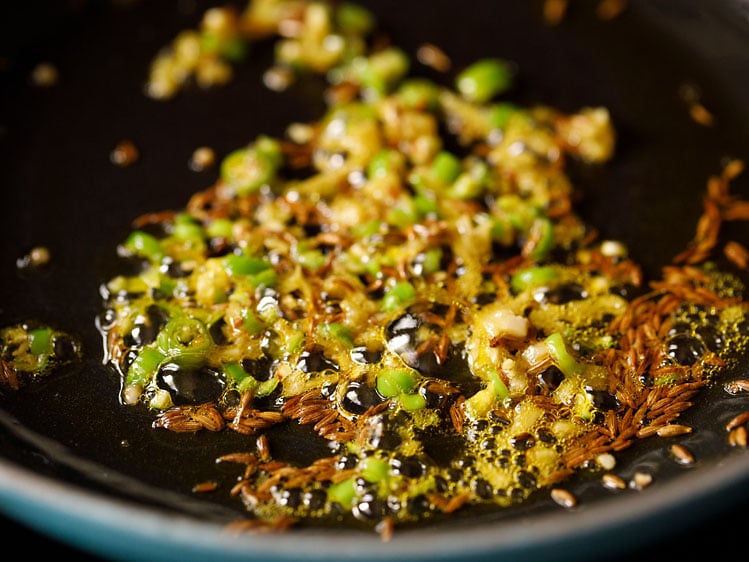
9. Now either switch off the heat or reduce it to low, then add:
- Cooked green peas
- ½ teaspoon red chilli powder
- 1 pinch of asafoetida (hing)
- The prepared dry spice mix
- 1 to 2 teaspoons dry mango powder (amchur)
The mango powder is what gives the Punjabi Samosa filling its signature tangy flavor that balances so well with the savory, spicy flavors of the other stuffing ingredients.
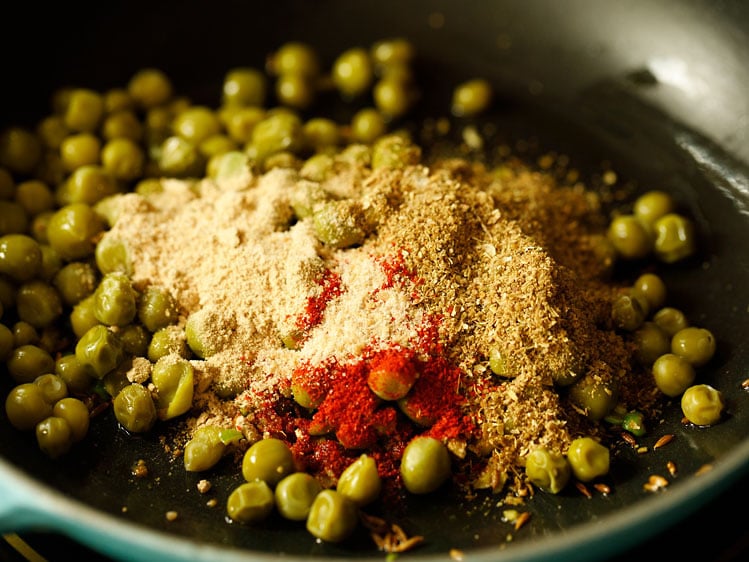
10. Stir together and sauté for a minute. You can add less or more dry mango powder depending upon personal taste.
I added 2 teaspoons as just 1 teaspoon was not quite enough sour flavor for me.
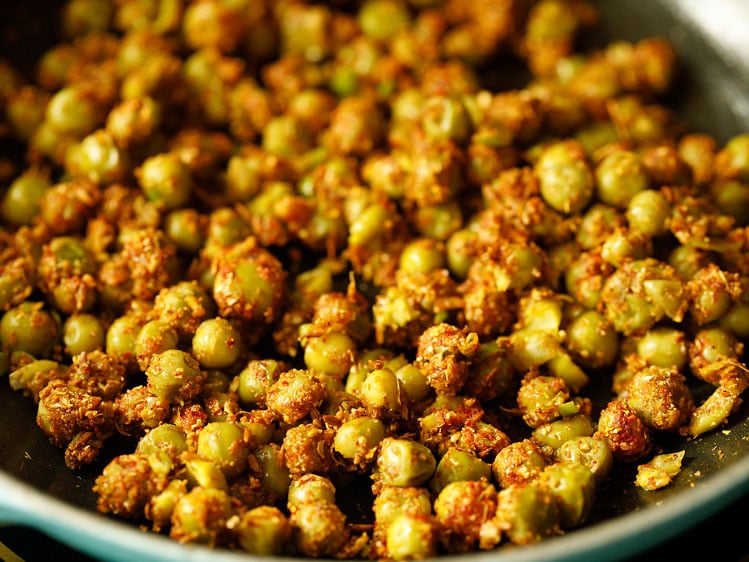
11. Next add potato cubes, salt as required and 1 to 2 tablespoons chopped coriander leaves (cilantro) to the skillet.
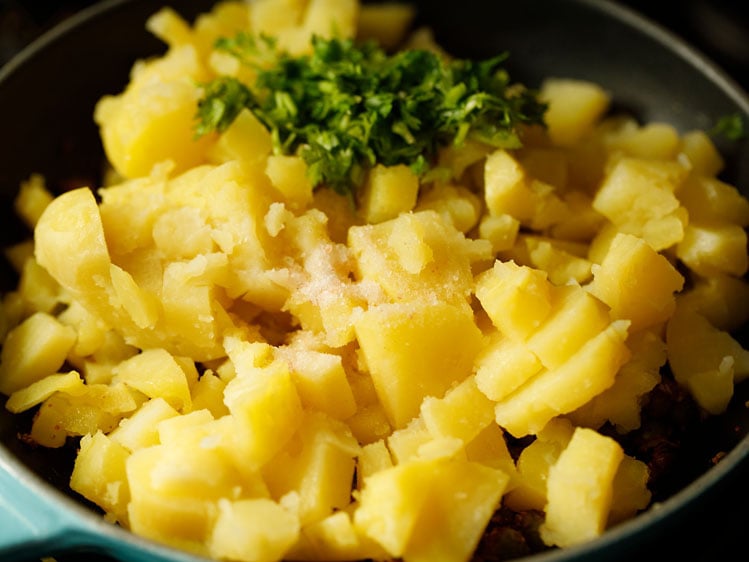
12. Mix very well and sauté for a minute. Check the taste, and add more of the spices, salt or dry mango powder if needed.
Cover and set the filling aside while you make the dough.

Make Samosa Pastry Dough
13. In a large mixing bowl combine 2 cups all-purpose flour (250 grams), 1 teaspoon carom seeds, 1 teaspoon salt and 6 tablespoons ghee (50 grams).
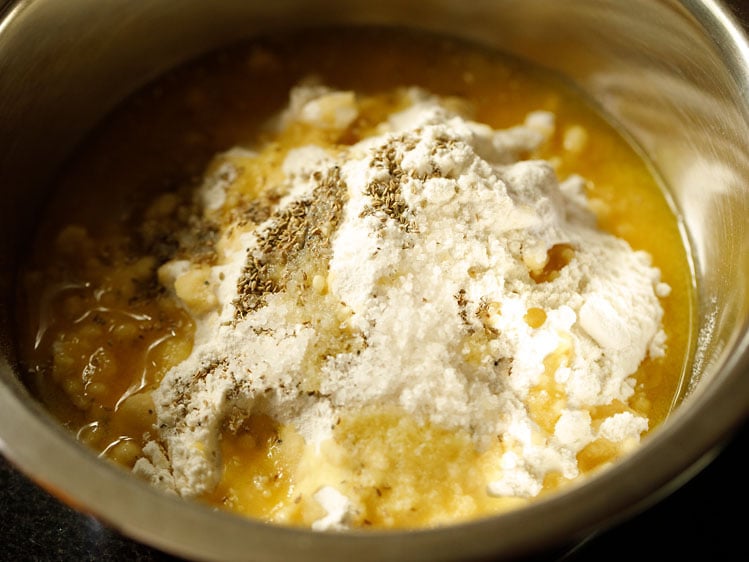
14. With your fingers, mix the ingredients together until they make a breadcrumb-like texture that holds its shape when you press a portion of the mixture.
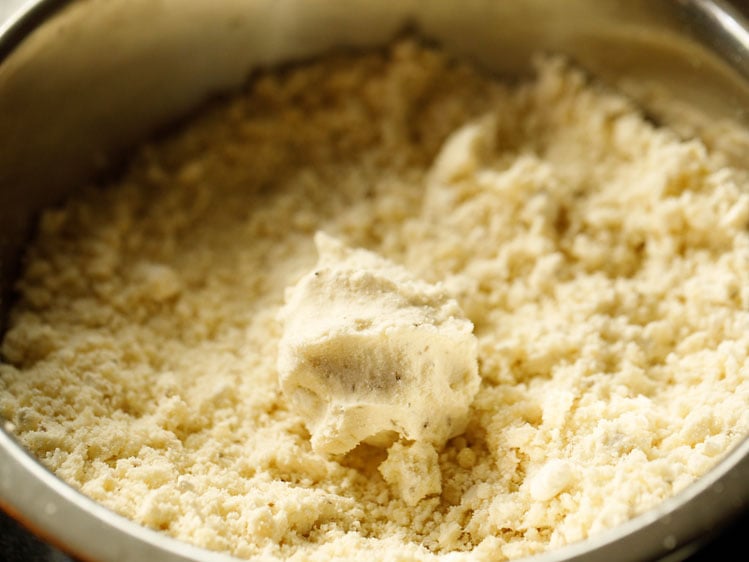
15. Then, working just a bit at a time, add in 7 to 8 tablespoons water in parts and knead.
You can add 1 to 2 tablespoons extra water if needed if the dough looks floury or dry.
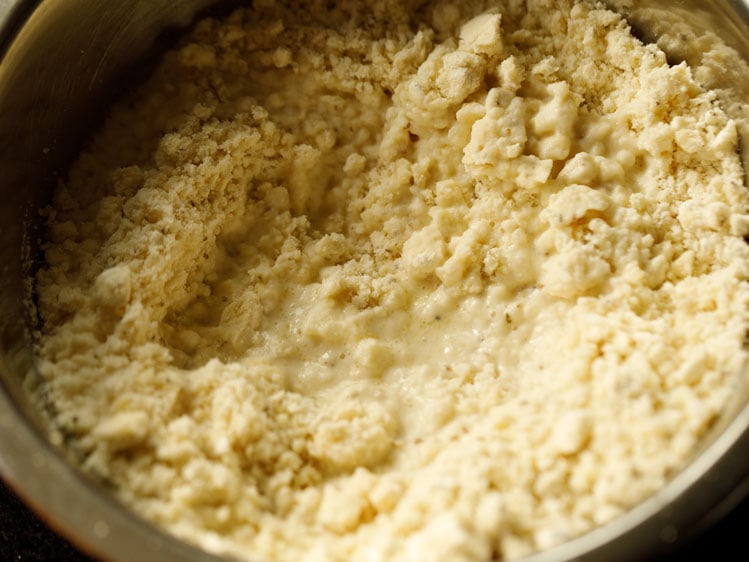
16. Continue kneading to form a firm, tight dough. It should not be soft or sticky. Cover the dough with a moist kitchen towel and let rest for 30 minutes.
In case if your dough becomes too moist or sticky then add a few tablespoons of flour. Mix and knead again to a firm dough.
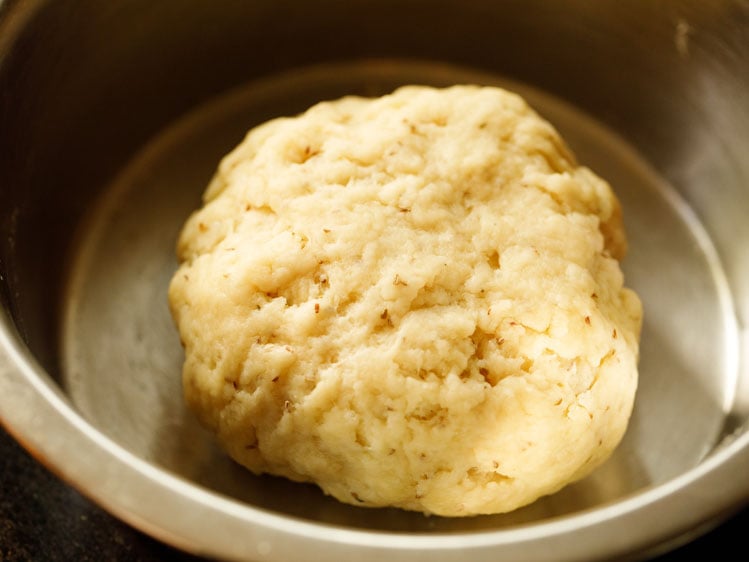
Shape, Fill & Fold
17. After the dough has rested, divide it into 6 to 7 even pieces. Take each piece and gently roll in your palms first to smooth and soften. Place it on your work surface or on the rolling board.
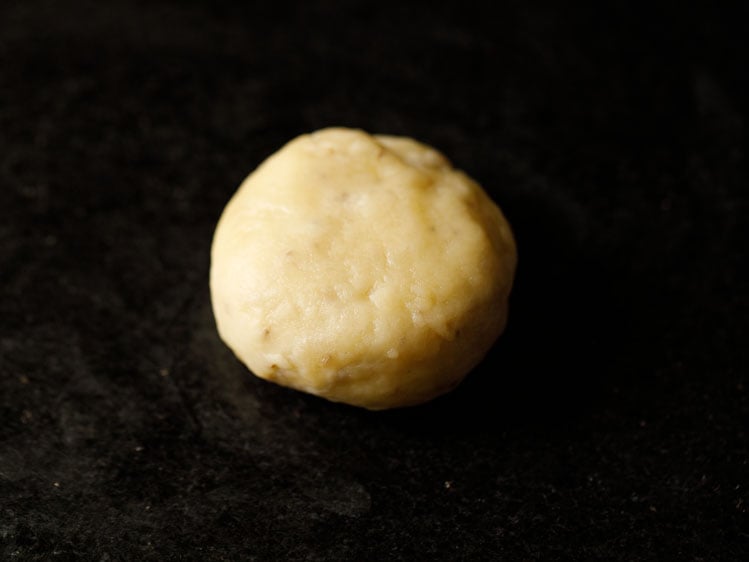
18. Then roll it with a rolling pin, being mindful to keep the thickness even at 1 mm and not too thin.
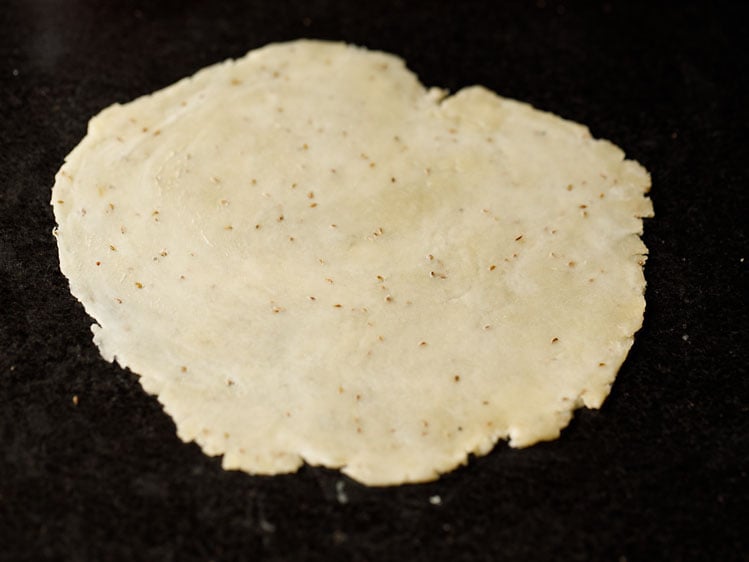
19. Cut the with a knife or a pastry cutter, right through the center of the rolled pastry dough.
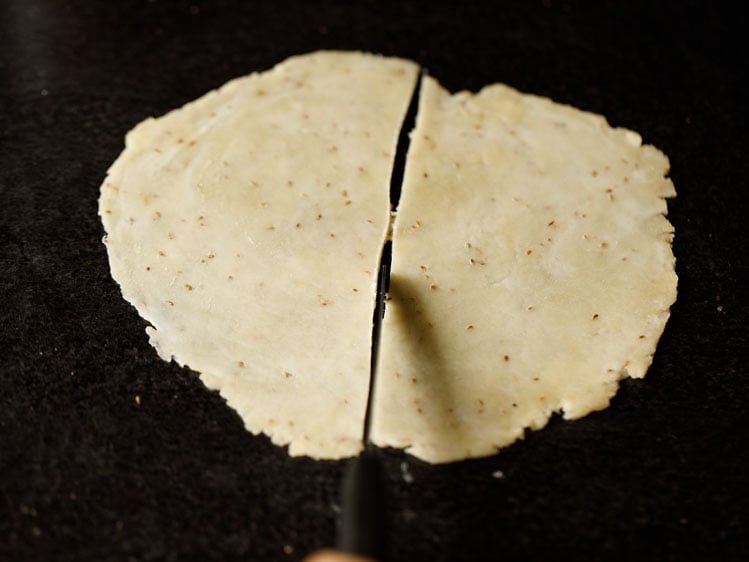
20. Use a rolling pin to gently flatten the half moon shape to make even.
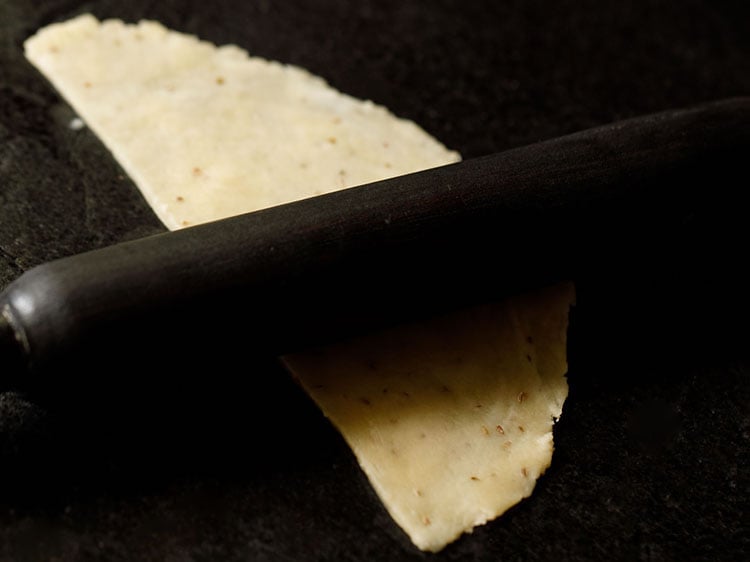
21. Use a pastry brush to lightly brush the dough with water around all of the edges.
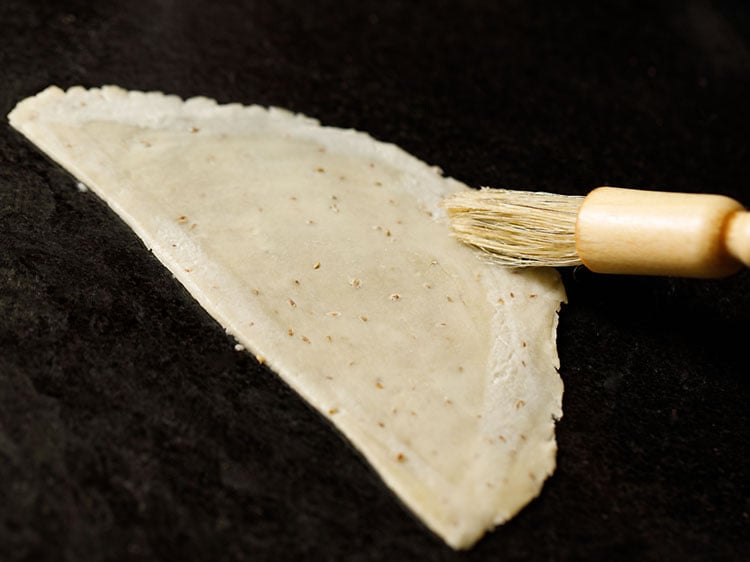
22. Next, fold to join the straight edged side together to form a cone, like shown in the photo below. Be sure to press the edges well so that they are sealed!
The cone is now ready to be stuffed with the potato and pea filling.
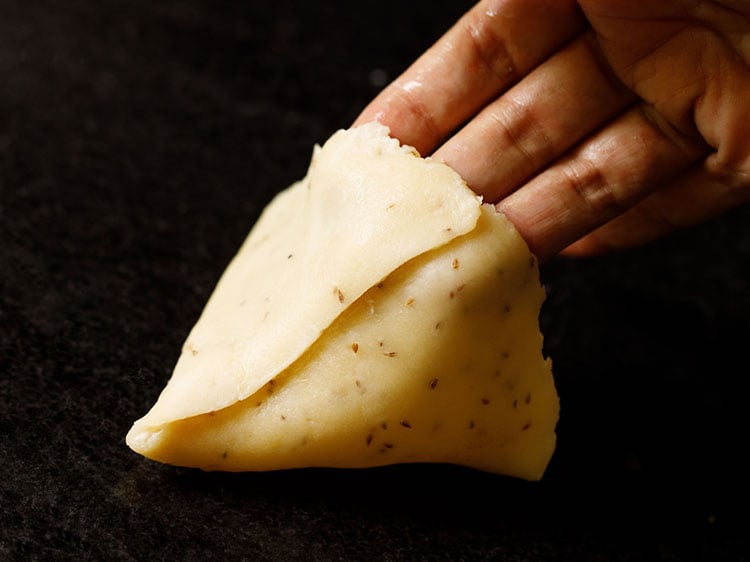
23. Carefully spoon and lightly pack the prepared potato and pea stuffing into the cone.
Make sure to not over or under-fill to prevent the samosa from bursting during the frying process.
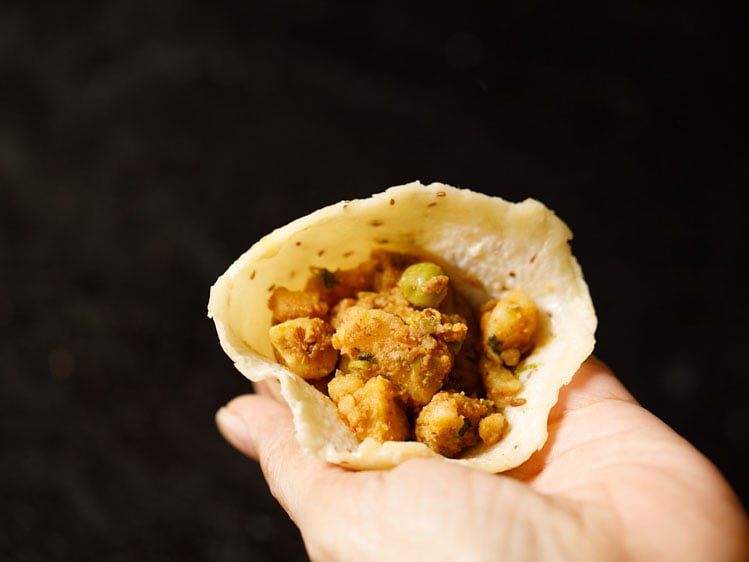
24. Crimp and pinch the edges to close as shown in photo below. This helps the samosa to stand once made.
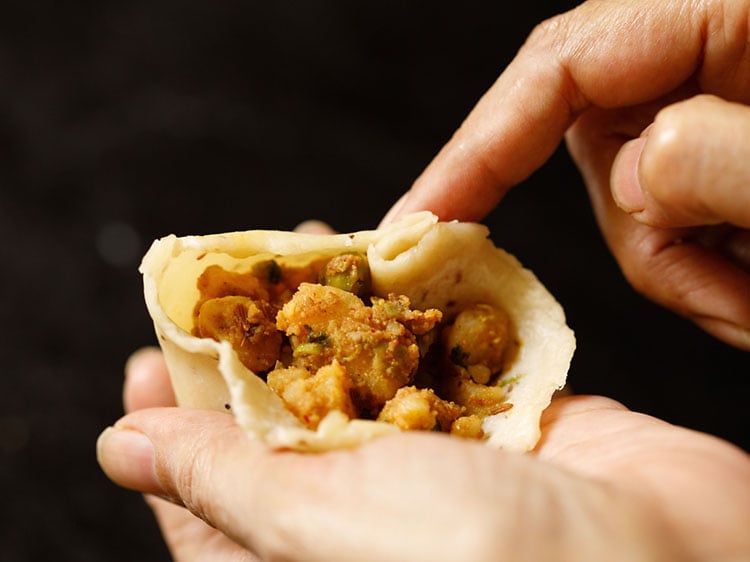
25. Evenly press all of the edges, making sure there are no cracks in the dough. The edges should be sealed very well so that the stuffing does not come out while frying.
Prepare all the samosa this way as described above, and cover with a moist kitchen napkin to keep them from drying out.
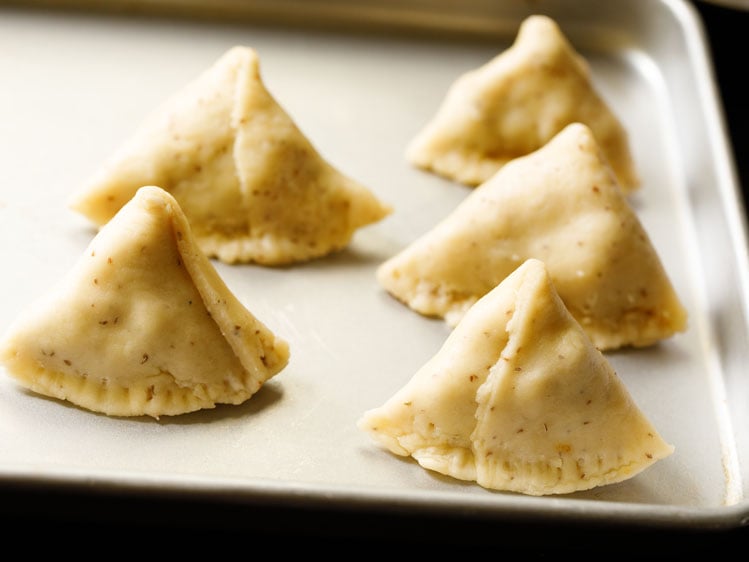
Deep Fry Samosa
The final step to making the best samosa is to fry them to a perfectly crisp golden brown.
Use any neutral flavored oil to deep fry – sunflower oil, canola oil, vegetable oil, safflower oil, grapeseed oil are some options.
26. Heat the oil for deep frying in a kadai or pan. Test the oil by adding a small piece of dough – it should come up quickly if the oil is hot enough for frying.
Once the oil becomes medium-hot, gently slide 3 to 4 of the prepared stuffed samosas into the oil, and then immediately reduce the heat to low.
Do not overcrowd the pan to ensure each one of them fries evenly!
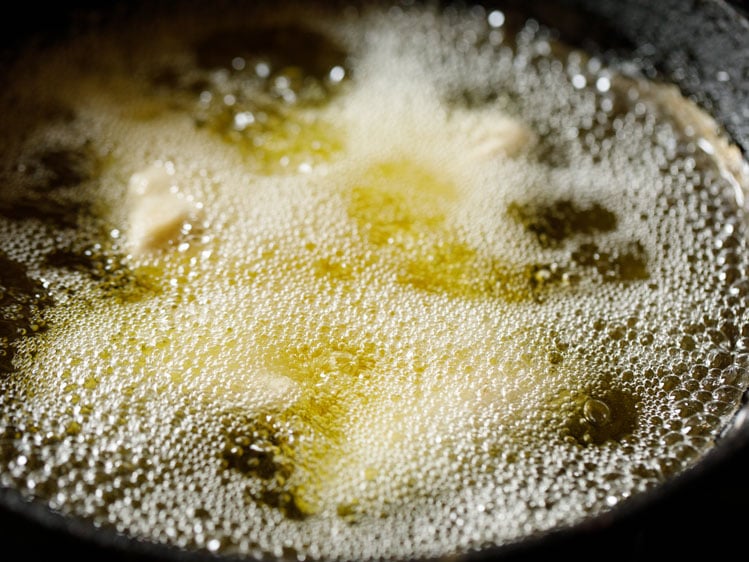
27. Fry them on low to medium-low heat, keeping an eye on them so they don’t burn.
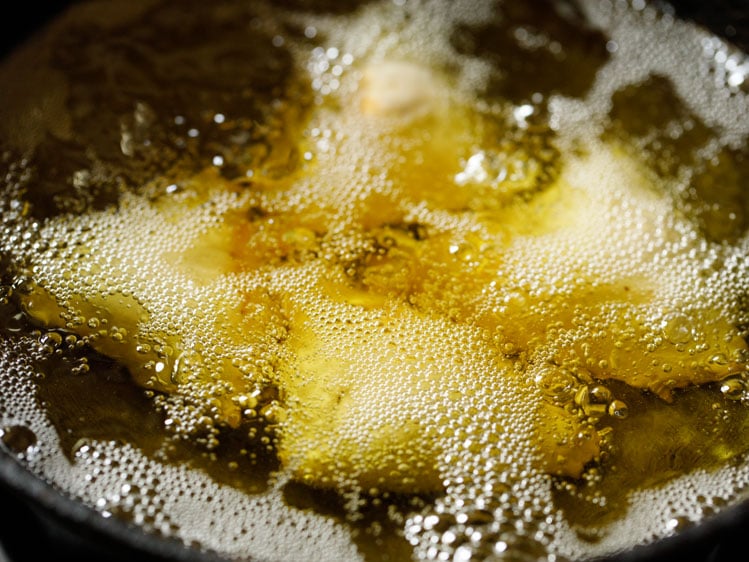
28. When one side is pale golden, use tongs or a slotted spoon or skimmer to gently turn each samosa over and continue frying.
This way you will have to turn a couple of times for even cooking. Be gentle and careful while turning them as they are heavy and oil can spill out.
Frying these take a lot of time, so you have to be calm and patient!
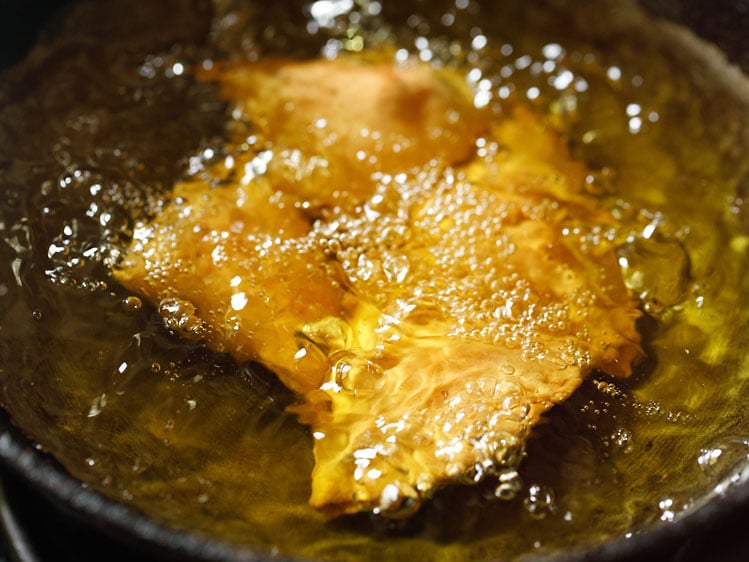
29. Fry until each aloo samosa is crisp and golden. The oil will stop sizzling once the samosas are fried well. They will become nicely crisp and golden.
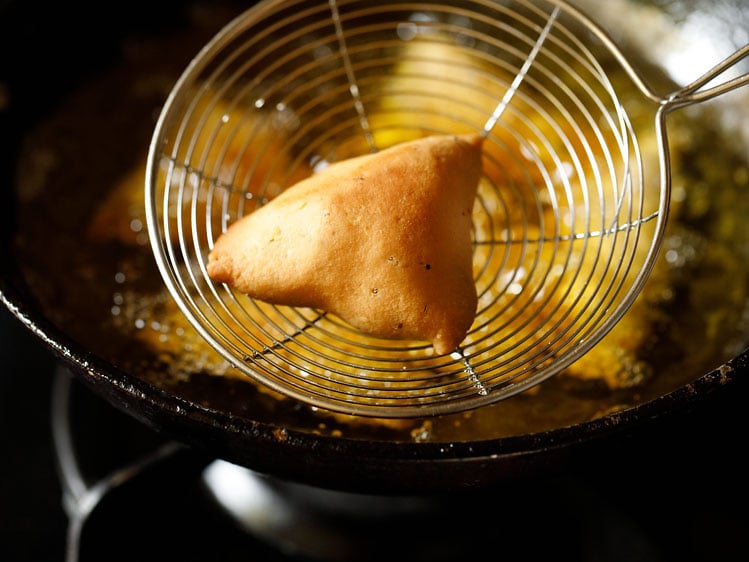
30. Use a skimmer spoon or spider spoon to carefully remove fried samosa from the oil, and place them on paper towels to remove extra oil.
Repeat the frying steps with the remaining batches of Aloo Samosa. Reduce the heat when you begin to fry the next batches. Regulate the heat as needed while frying these.

31. Serve Punjabi Samosa hot or warm or at room temperature with Coriander Chutney or Tamarind Chutney, or with a zesty tomato ketchup.
The pairing of Aloo Samosa with Masala Chai is irresistible and much loved in India.
You can also serve them with Chole Masala. This dish is popularly known as samosa chole. Another popular chaat snack made with potato samosa is Samosa Chaat.
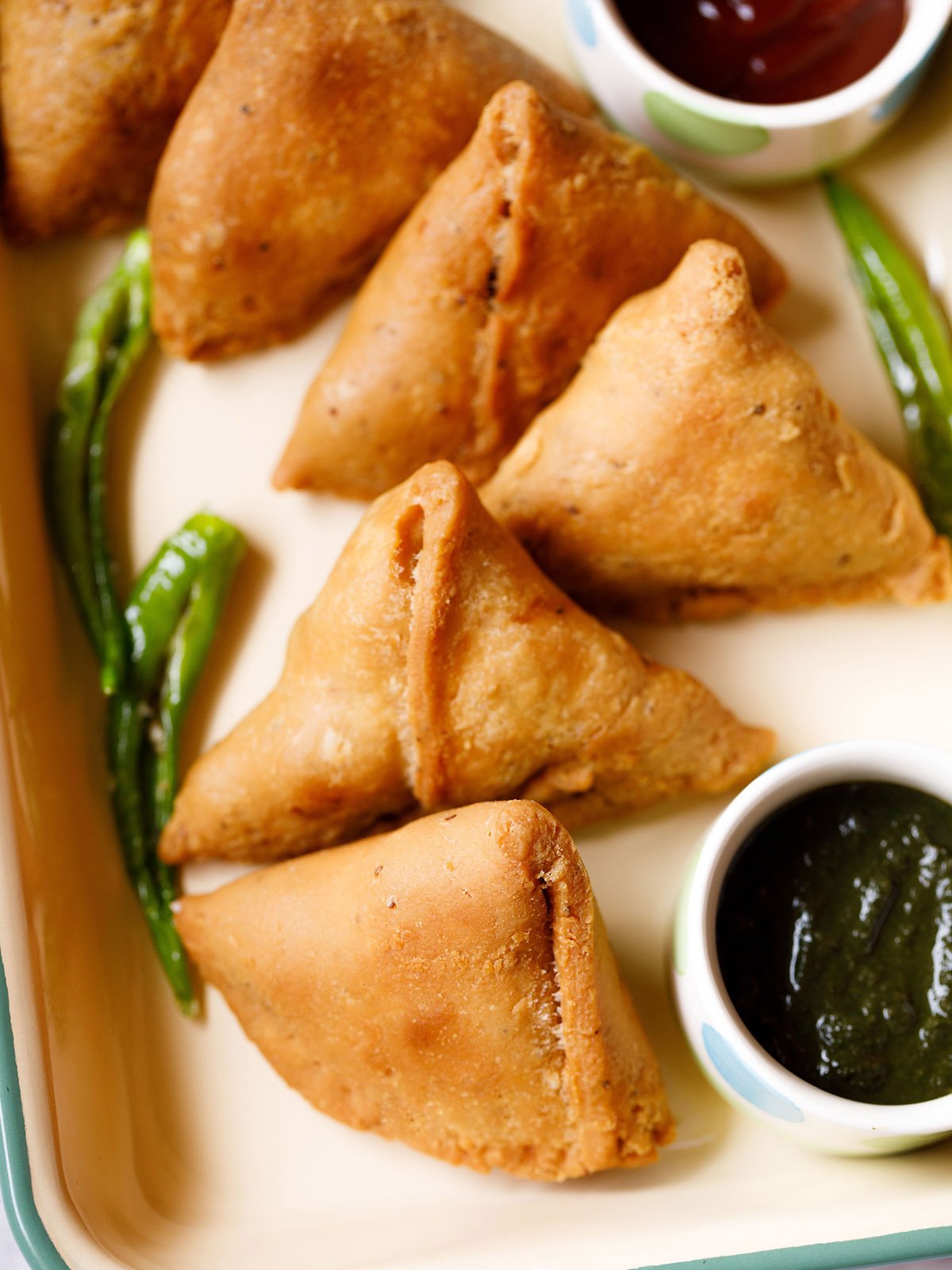
Other Delicious Fillings
Samosa stuffing varies widely across India, depending on the region.
In Delhi and Punjab, a classic filling includes whole (not mashed) potato cubes, sometimes with green peas and chopped green chilies. The flavor is tangy thanks to the addition of dry mango powder or dry pomegranate powder, and a few whole or ground spices.
Some versions include raisins for a sweet-sour taste, and cashews for added crunch. In other places, the stuffing is completely mashed and heavily spiced.
If green chillies are not added to the stuffing, fried green chilies are often served on the side.
Other regional variations include:
- Mixed vegetable samosas with carrots, cauliflower, peas, and potatoes.
- Onion samosa made with a spicy mix of onions and poha (flattened rice).
- Sweet samosa stuffed with khoya, nuts, and dry fruits—popular during Diwali and Holi.
- Paneer samosa with soft paneer cubes in a mildly spiced filling.
- Cocktail samosas, which are mini in size and filled with dry lentils, nuts, and spices.
- Singara, the Bengali version, is smaller, crispier, and often filled with spiced potatoes, cauliflower, and peanuts.
If you have leftover samosas or just want to try something different, here are some tasty snack ideas with samosas:
- Samosa Chaat – Crushed samosas topped with spicy Chana Masala, green and tamarind chutneys, yogurt, onions, and sev. A flavourful street food that’s tangy, spicy, and filling.
- Samosa Pav – A Mumbai-style snack where a samosa is placed inside a Pav bun, served with green chutney, sweet chutney, and fried green chillies.
- Samosa Sandwich – Bread slices layered with green chutney and a samosa (whole or slightly mashed), often toasted or grilled until crisp.
Expert Tips
Wondering how to get that perfectly flaky, crispy samosa crust? Here’s what I’ve learned and tested:
- Proportion of fat: The amount of fat (“moyen” in Hindi) in the dough is crucial. I follow a 1:5 fat-to-flour ratio by weight – so for 250 grams of flour, I use 50 grams of fat. This is the same professional ratio one of my culinary mentors always recommends.
- Proportion of water: The dough should be tight and firm – not soft like roti or bread dough. Add water in parts as needed. Too much water will make the crust soft and prone to oil absorption.
- Rolling the pastry: Roll the dough to an even 1 mm thickness. Too thick means longer frying and harder crust; too thin and the stuffing may burst during frying.
- Seal Properly to Prevent Leaks: When shaping the samosa, moisten the edges with water and press firmly to seal. Any gaps can cause the stuffing to leak into the oil while frying.
- Rest the Dough: After kneading, let the dough rest for at least 30 minutes covered with a damp cloth. This makes the dough easier to roll and helps avoid shrinkage.
- Don’t Overstuff: Avoid adding too much filling, or the samosa may burst while frying. Leave enough space to seal the edges securely and maintain the shape.
- Cool The Stuffing Completely: Always let the potato stuffing cool completely before using. Warm filling can make the dough soft and lead to cracks or splits while frying.
Two Frying Techniques
There are two effective ways to fry samosas for that perfect crust:
1. Low Temperature Frying
First heat oil on medium to medium-high. Add the samosas, then reduce to low or medium-low heat. This prevents oil absorption and helps the crust cook evenly without forming bubbles.
Avoid adding samosas to cold oil (they soak oil), or to very hot oil (they develop bubbles and stay undercooked inside).
2. Double Frying
This method takes more time but gives excellent results. First lightly fry the samosas until the crust turns opaque and creamish-white – do not let them brown. Remove, rest, and then fry again on low heat until golden and crisp.
Both methods yield perfectly cooked samosas—crisp outside, soft inside, just like the halwai-made ones.
Air Fryer Samosa – A Lighter, Crisp Option
Yes, samosas can be air-fried! The texture is surprisingly close to the deep-fried version, minus the extra oil.
Preheat your air fryer at 180°C (356°F) for 10 minutes. Brush samosas lightly with oil and air-fry at the same temperature until golden and crisp.
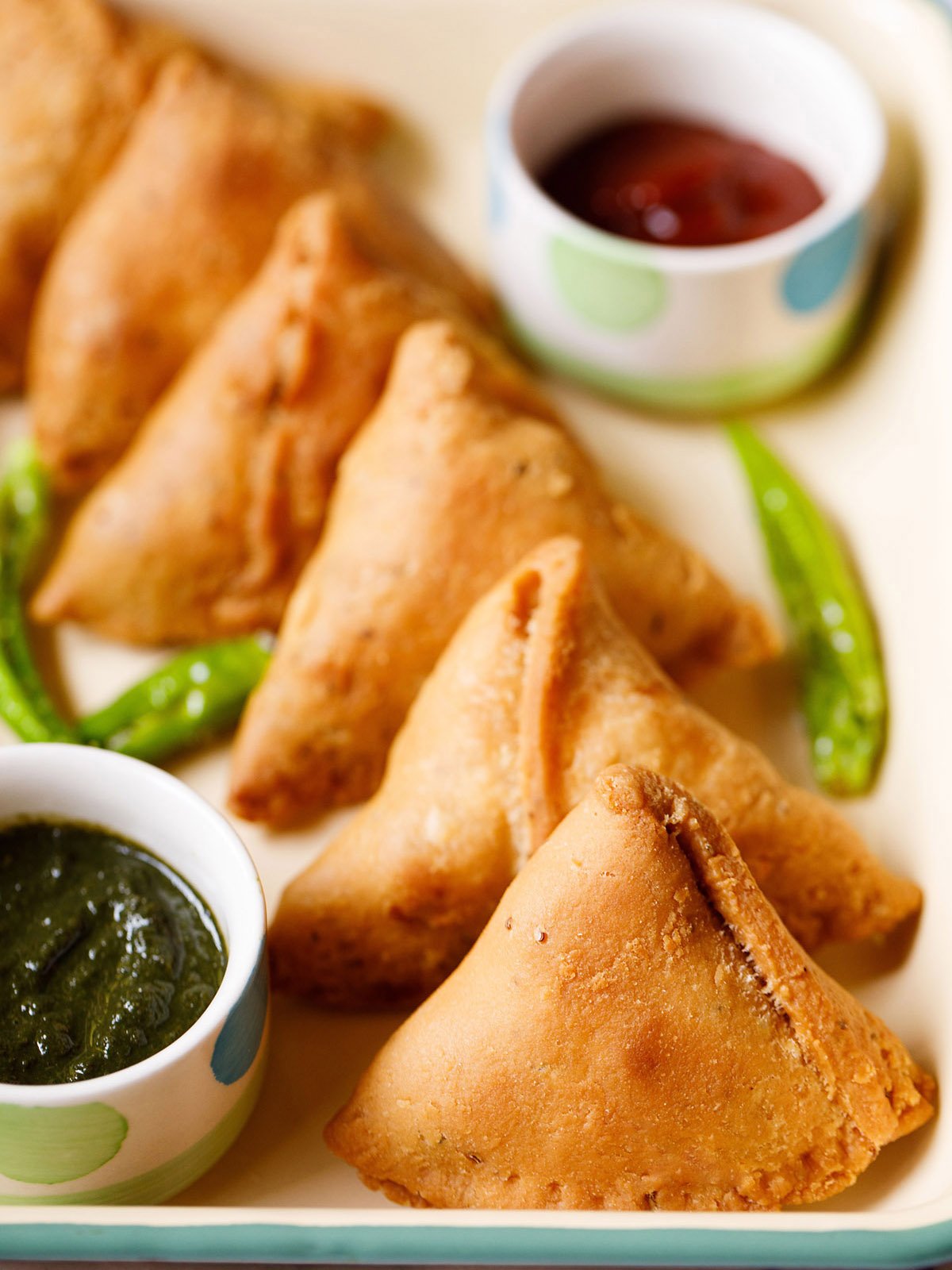
FAQs
I don’t have amchur. What can I use instead?
Add 1 teaspoon lemon juice, or 2 teaspoons dried pomegranate powder for a tangy kick.
Can I freeze samosa?
Yes! Shape and freeze them raw, or lightly fry until the crust turns opaque, then freeze. Bring to room temperature before final frying.
Why are there air pockets on my samosa?
A few air pockets are normal, but the outer crust shouldn’t be covered with too many. This usually happens if the dough is too soft or the oil is too hot. Make sure the dough is firm and fry the samosas on low to medium-low heat.
Can I use puff pastry, spring roll wrappers, or phyllo dough?
Yes!
– Puff pastry: bake or air-fry
– Spring roll wrappers: bake or fry
– Phyllo dough: bake only
Why did my samosa turn soft or soggy?
Soft dough or frying in oil that’s too cool can make samosas soggy. Always use a tight, firm dough and fry on low to medium heat.
How long can I store samosas?
Samosas stay fine for a few hours at room temperature. For longer storage (1 to 2 days), keep them in an airtight container in the fridge and reheat before serving.
Can I air-fry samosa?
Yes, see the air fryer instructions above.
Can I bake samosa?
Yes! Preheat the oven to 180°C (356°F) and bake for 30 to 35 minutes until the crust is crisp and golden. For more details and step-by-step photos, you can also check out my recipe of Baked Samosa made with whole wheat flour.
Need More Help? Common Queries Covered
Can I use whole wheat flour?
Yes, but the crust will be denser and less flaky. Add more water when kneading.
How to make fried green chilies served with samosas?
Slit whole green chilies, shallow fry till blistered. Sprinkle salt or chaat masala.
Alternate method: stuff with dry mango powder and salt, then shallow fry.
How to make this recipe vegan?
Simply use neutral oil instead of ghee in the dough.
Can I add onions in the stuffing?
Traditional Punjabi samosas don’t use onions or garlic, but you can add them. Just note that they change the flavor and moisture content.
Step by Step Photo Guide Above
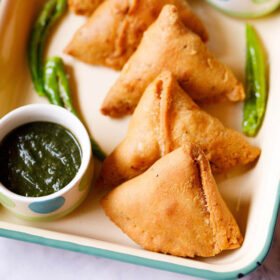
Samosa Recipe (Crispy Aloo Samosa)
Ingredients
For making samosa pastry
- 2 cups (250 grams) all-purpose flour (maida)
- 1 teaspoon carom seeds
- 1 teaspoon salt or add as required
- 6 tablespoons (50 grams) Ghee (clarified butter)
- 7 to 8 tablespoons water or add as required
For cooking potato & peas
- 3 medium potatoes (300 to 350 grams) potatoes or 3 cups chopped boiled potatoes
- ½ cup (180 grams) green peas – fresh, can use frozen peas
- 2 cups water – for steaming
Other ingredients
- 1 tablespoon oil – I used mustard oil. sunflower, canola, grapeseed oil can be used
- ½ teaspoon cumin seeds
- 1 teaspoon ginger – finely chopped, or 1 inch peeled ginger
- 2 teaspoons green chillies – finely chopped or 2 tsp finely chopped serrano peppers or 1 to 2 green chillies
- ½ teaspoon Red Chili Powder or cayenne pepper
- 1 pinch asafoetida (hing) – optional
- 1 to 2 teaspoons dry mango powder (amchur), adjust to taste
- salt as required
- 1 to 2 tablespoons coriander leaves (cilantro), chopped
- oil for deep frying – as required, any neutral flavored oil
Whole spices to be ground
- ½ inch cinnamon
- 1 clove – optional
- 3 black peppercorns
- 1 green cardamom
- ½ teaspoon cumin seeds
- ½ teaspoon fennel seeds
- 2 teaspoons coriander seeds
Instructions
Making samosa pastry dough
- Take the flour, carom seeds, salt in a bowl. Mix well and add ghee.
- With your fingertips rub the ghee or oil in the flour to get a breadcrumb like consistency.
- The whole mixture should clump together when joined and not fall apart.
- Add water in parts and knead to a firm dough.
- If the dough looks dry or floury, then add 1 to 2 tablespoons more water and knead.
- Cover the dough with a moistened napkin and set aside for 30 minutes.
Making potato and green peas stuffing
- Steam or boil the potatoes and peas till are cooked completely. Drain them of any extra water in a colander or sieve.
- Peel the boiled potatoes and chop them into small cubes
- Dry roast all the whole spices mentioned in the above list until fragrant taking care not to burn them.
- When the spices are warm or cool at room temperature, grind them in a dry grinder or coffee grinder to a semi-fine or fine powder.
- Heat oil in a pan. add the cumin seeds and crackle them.
- Add the ginger and green chillies. Sauté for a few seconds until the raw aroma of ginger goes away.
- Add the steamed green peas, red chili powder, the freshly ground spice powder, dry mango powder and asafoetida.
- Stir and sauté on a low heat for 1 to 2 minutes.
- Add the potato cubes. Mix very well and sauté for about 2 to 3 minutes on low heat with frequent stirring.
- Set aside the potato filling aside to cool at room temperature.
Assembling & shaping samosa
- After resting the dough for 30 minutes, divide the dough in 6 equal pieces.
- Take each piece and roll in your palms first to make a smooth ball.
- Then roll it with a rolling pin keeping the thickness to 1 mm throughout.
- Cut with a knife or a pastry cutter through the center of the rolled samosa pastry.
- With a brush or with your finger tips, spread some water all over the edges.
- Join the two straight ends forming a cone shape.
- Press the edges so that they get sealed well.
- Stuff the prepared samosa cone with the prepared potato-peas stuffing.
- Pinch a part on the edge (check the video & photos). This helps the samosa to stand once it is shaped.
- Press both the edges. Be sure there are no cracks.
- Prepare all the samosa this way and keep covered with a moist kitchen napkin.
Frying Samosa
- Now heat oil for deep frying in a kadai or pan. Once the oil becomes hot (test by adding a small piece of dough – it should come up quickly once added to the hot oil). Gently slide the prepared stuffed samosa & quickly reduce the flame to low.
- Turn over in between and fry until golden. Drain the fried samosa on paper towels to remove excess oil.
- Fry them in batches. For frying the second batch, again increase the temperature of the oil to medium-heat. Do not overcrowd the pan while frying.
- Add the samosa and then lower the heat, thereby decreasing the temperature of oil.
- This way fry all the samosa in batches.
Serving suggestions
- Serve samosa hot or warm with coriander chutney, tamarind chutney or tomato ketchup.
- They can also be served with a yogurt dip or plain raita. Another way is to serve it with chana masala (chickpea curry).
- We usually pair samosa with masala chai or ginger chai.
- Even bread or pav (Indian bread rolls) can be served with it.
- Whatever you serve this snack with, remember to have hot masala chai with it.
Video
Notes
- Roasting whole spices: If you are short of time to roast and grind the whole spices, then in a small bowl, simply mix 2 teaspoons ground coriander (coriander powder), ½ teaspoon ground cumin (cumin powder), ½ teaspoon ground fennel (fennel powder) and ½ teaspoon garam masala powder. Add this prepared spice mix at the step when the green peas and remaining ground spices are added while making the stuffing mixture.
- Dry mango powder: Replace mango powder with 1 teaspoon lemon juice or 2 teaspoons dry pomegranate powder.
- Green peas: Simply skip if you do not have these.
- Asafoetida: Skip it completely if you cannot find asafoetida in your city.
- All-purpose flour: You can use pastry flour and even whole wheat flour. You may need to add more water when using whole wheat flour.
- Ghee: Replace ghee with a neutral tasting oil.
- Use the amount of fat as specified in the recipe to get a flaky crust.
- Add water just enough to help you form the dough. Do not make the dough soft like a bread or roti dough. The dough should be firm and tight.
- A soft samosa dough will make air pockets happen on the crust. Too much moisture in the dough makes the crust soft as well as gives it plenty of air pockets.
- Fry samosa on a low to medium-low heat. The oil should not be medium-hot or at a high temperature as this will result in having air-pockets on the crust and will leave the crust undercooked from inside.
- The oil for deep frying can be a neutral flavored oil like sunflower, safflower, canola oil or any good vegetable oil.
- You can shape samosa and freeze them or you can fry them until the crust becomes opaque and then freeze.
- The fried samosa can be kept at room temperature for some hours. If you are not able to finish them all, then store them in an air-tight container in the fridge for a couple of days. When serving you can warm them on a skillet or in an oven until warm (at 170 degrees celsius in a preheated oven).
- Air-frying: Preheat air fryer at 180 °Celsius for 10 minutes. Brush samosa with oil and air fry at 180° Celsius till the crust is golden.
- Baking: Bake samosa in a preheated oven at 180° C/356° F for 30 to 35 minutes or until the crust becomes crisp and golden.
Nutrition
Samosa recipe from the archives was first published on November 2013.

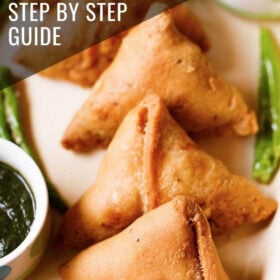
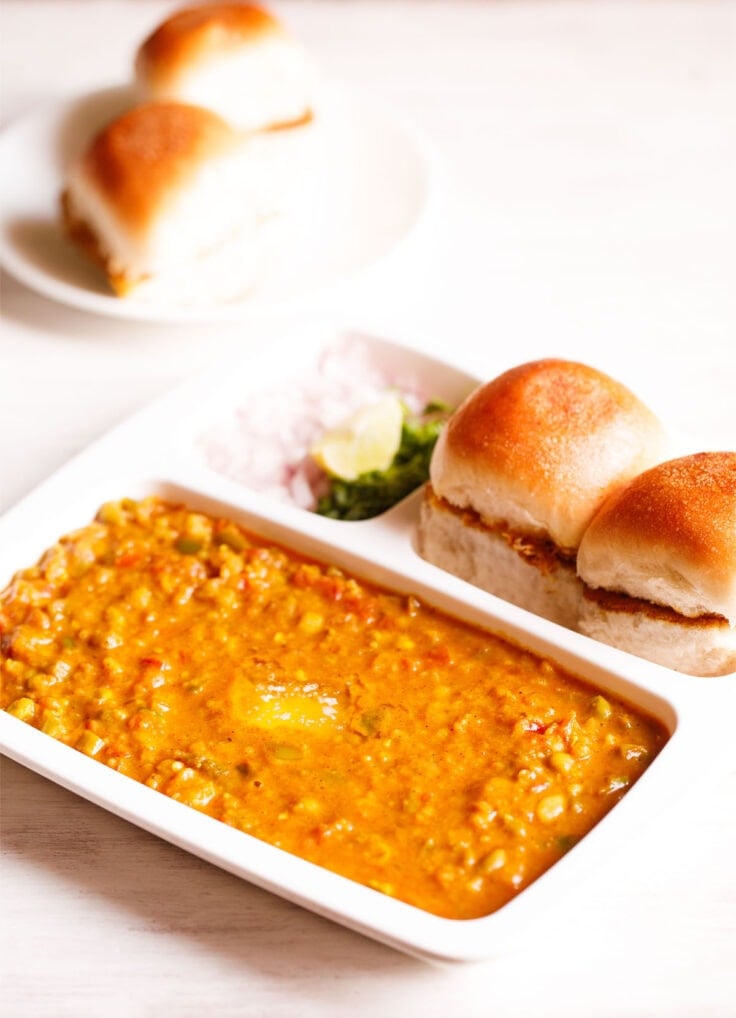
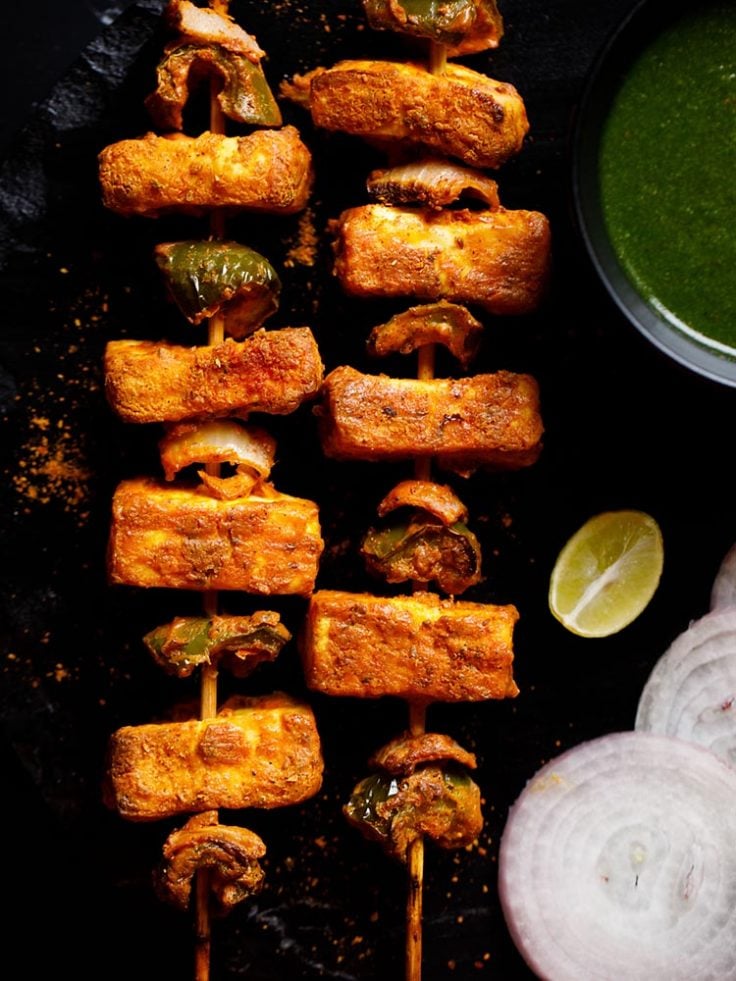
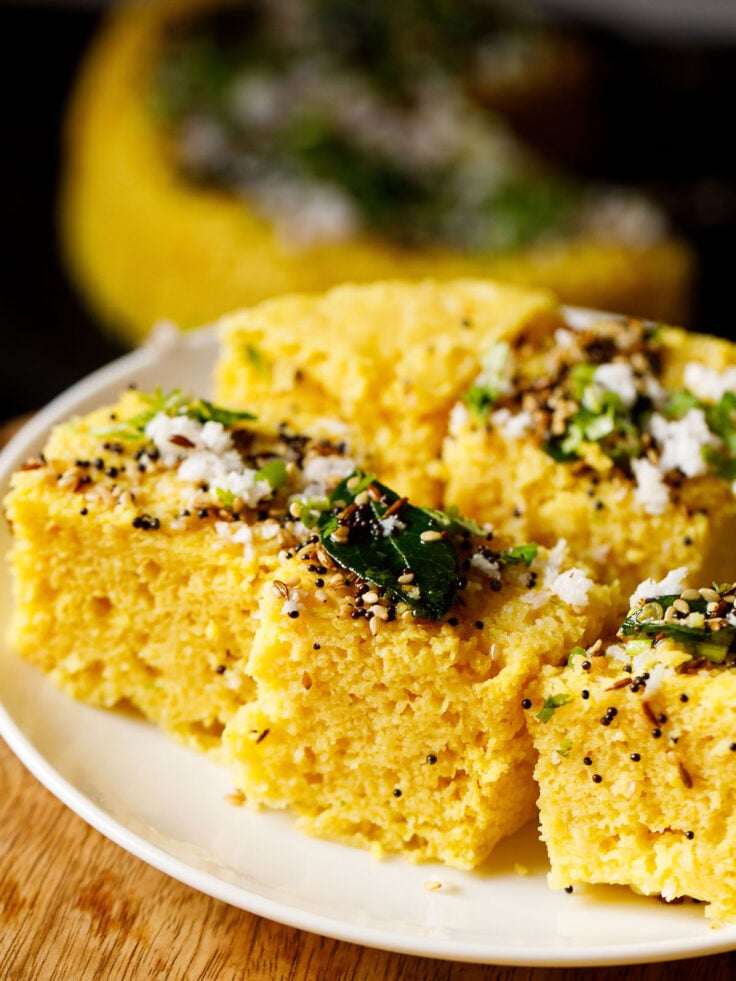
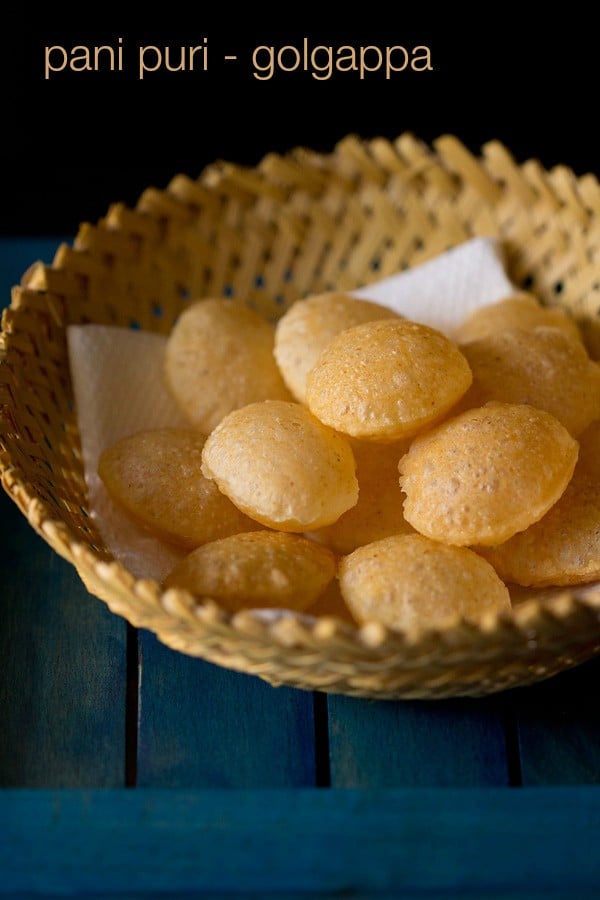
Thankyou
If you partially fry and then freeze then how do you finish cooking? Do you fry from frozen or defrost and finish frying?
If you’ve partially fried and then frozen the samosas, you can fry them straight from the freezer — no need to thaw. Just make sure to fry on medium-low to medium heat so they cook evenly and the crust gets crisp.
That said, if there’s any surface ice or moisture, it’s a good idea to let them sit out for 5 to 10 minutes before frying. This helps avoid oil spluttering. Also, don’t overcrowd the pan and slide them in gently.
This samosa recipe is seriously better than a takeout one. Love it!
Thank you so much. Really happy to hear you enjoyed it and means a lot that you liked it even more than takeout.
Hi. First of all, thank you for all your wonderful recipes. I live in a small village in the middle of the mountains in Mexico, and it is impossible to find anything from India.
Your recipes have become famous amongst my friends here. I have made these samosas and they are all coming to sample them in a few hours. I am sure they will be a success.
Thank you again for your wonderful descriptions, photos and videos. I love Indian cuisine and your recipes always warm my heart, and my tummy 🙂
Thank you so much. I am so glad to read your feedback on the samosa as well as on the other recipes. Thanks again.
Excellent recipe. I have two questions –
Why samosas are always called as Punjabi samosas? especially in restaurants and in stores. Are there any other types or varieties of samosas? If so, what are the differences?
Instead of using all purpose flour, can I use pastry flour? This is available separately here in USA.
Thanks for your help,
There are many types of samosa variations. The Punjabi samosa has a tangy stuffing made with potatoes and green peas. The tangy flavor comes from using dry mango powder or dry pomegranate powder which are often used in Punjabi dishes.
You could try with pastry flour. It should work to give you a crispy and flaky texture.
Top recipe and flavour! I started making this for home and then offered them at a local craft market – and quickly sold out!
The only ingredient I can’t source is the ajwain but I have stuck faithfully to the rest of the ingredients.
Highly recommended for spice fiends every where as you can up the heat with extra chilli without losing the flavour. The amchur is a killer!
Greeting from the Fairest Cape, South Africa.
Thanks so much for this lovely feedback and review on the recipe. Glad!
delicious!
Wow ! Not so difficult by the way. Thanks for easy recipe. Love it.
Loved this samosa recipe from all the other various recipes that I have made from the internet. The texture of the samosa crust, the flavors, tang and taste of the potato stuffing is spot on.
Had made for a party. The samosas were so good, that even my relatives started to ask about the samosas.
They thought I had brought them from a shop. They could not believe these were homemade. Loved by everyone at the party.
I even baked a few for the health nerds in our family and they too loved it. Will make again. Thanks for sharing such an authentic and true recipe.
Thanks so much for this awesome feedback. Happy to know. Most welcome. Thanks for the rating too.
This recipe never fails! Thank you for the detailed photos and explanation. We love having samosas at our place for family gatherings and everybody loves them!
Great and thanks for sharing.
By following your step by step recipe it’s not difficult at all to make
Thank you!!
Came out perfect and tastes delicious!
Thanks a lot for this feedback and the rating as well. Most welcome.
As always good recipe and great explanation! The only problem is that these samosas disappear too fast…
Agree! And thank you.
Hi, I’ve tried a few different samosa recipe, yours is my favorite by far! However, my feet gets really tired from prolonged standing so I tried baking. I wasn’t pleased with the results.
Then I decided to fry it out if curiosity. It came out perfectly with only a few minutes of frying . So in addition to frying slowly or frying twice, Bake and Fry works too! My feet are happy !
Yes, baked samosa has a different texture as compared with a fried samosa. Thanks for sharing this method of baking and frying. Agree, it will take less time to fry. Thanks also for the lovely review on the recipe.
Your recipes are very good they are very helpful if we ever have any celebration we can quickly prepare delicious snacks easily
Thanks a lot and glad to read your feedback.
This is the first page which I look for whenever I want to try a new recipe… And it has never failed me…be it eggless chocolate cake for my kid’s birthday or a simple chutney for the humble idli. Looking to make stuffed rosette breads using samosa filling. This looks simple and tasty! Thanks for all your efforts!
Sheetal
Thanks a lot Sheetal. Glad to read your lovely comment and feedback. This filling tastes very good. I am sure it will taste good in stuffed rosette bread. Most welcome.
I’ve been following your recipes for a long time now. The way you explain, no one does. So intricate and the tiny little tips are wonderful. Thank you, for being there?
Thanks a lot Swati and glad to read your feedback. Most welcome and Happy Cooking.
i am very fond of samosa…in fact most of person….but the way you have described for making it …very commendable….keep publishing more…
thank you ????
Awesome! Tried making this for the first time and the recipe is pretty accurate!
thanks a lot jen for this positive feedback and rating on samosa recipe.
Hi Dassana Mam! I have lot of passion for cooking. I love your blog and the way you post your recepies. Thank you ????. You are my inspiration , I learned so many recepies from your blog. Thanks to you and your recepies.
thank you revathi and i feel so good reading your comment. wish you all the best in your life. happy cooking.
I have a question about the frying method. When I add the Samosa to the oil, do I fry it on both sides first and then lower the heat to complete the frying process. Thanks, Donna. (I plan to try this recipe on the week-end.)
when you fry the samosa, deep frying method has to be used. so the oil will be more and the samosa will be almost covered in the oil. so the entire samosa will be fried first. then you reduce the flame.
I always follow this website for cooking, love the clarity, description, and most of all i love the step by step photographs. the quality of the images is superlative. you make the food look exotic !
thanks a lot. glad to read your comment.
Can i bake these? Also can i use store bought samosa covers?
chez, yes you can bake them and also use store bought samosa covers.
Hi Dassana,
I have made samosas with this recipe before and they have tired out very delicious. I have done both methods, each one was equally good. I am planning on making this for a party. I need to make around 45 of these. Can I just quadruple the recipe? Could you help me in figuring out the amount of everything if I cannot quadruple it? Also for sake of convenience can I half fry the samosas the day before and refrigerate them and fry them before the event? What precautions should I take? Thanks so much.
nita, you can easily quadruple the recipe. for spice powders in the potato stuffing, i would suggest to add in parts. mix and taste and add more if required. you can half fry and freeze. or after shaping the samosas, also you can freeze. but before frying let them come at room temperature and then fry. oil can be medium hot if you have half fried.
Hi Dassana, I made 47 Samosas for the party and not one was left! I somehow managed to sneak one for my husband. All my American friends loved it. I skipped the green chilies but still it was delicious ???? and your chutneys were a hit too. I got so many compliments of been a good cook today but they really have to go to you! I can’t do a thing without your recipes. A big hug ???? to you dear. Thank you.
thats great nita and thanks for letting me know. thanks again. the recipes are there and they do aid or help, but finally its you doing all the cooking. so some credit should go to you too ????. hugs and a happy makar sankranti festival ????.
I made these today, they tasted really good. However I used half atta half maida so pastry was a bit less flaky and needed more water to bind the dough.Did see a few air bubbles but overall I am pleased with my first attempt.
Thank you for such tasty recipes
thanks sabina. when using atta more water is required to knead as atta absorbs more water. for less air bubble, fry at low flame and you will get less or no air bubble.
Thank you, Dasanna. I never thought I could make samosas at home. I followed your instructions step by step and got wonderful samosas that my husband appreciated as well. Thanks so much 🙂 -Divya
Welcome Divyapriya. Glad to know that both of you liked the samosas. making samosa takes time but its not so difficult as it appears to be.
Hi Dassana. I love your website. I keep coming back to it when I need to cook something new.Thank you for sharing your tried and tested recipes.I have made the punjabi samosas twice already.They turned out great. My husband said its the best ones he has ever eaten;even better than those sold in restaurants!! The credit is all yours.
I would like to make these samosas for my daughter who is studying in another city. She only has a microwave oven.Can I double fry and pass it to her? She could freeze and heat them in the microwave oven when she wants.Is that doable?Will they keep well and for how long?
thank you mansha. nice to read your comment. of course you can do this way for your daughter. just double fry first. once the samosas cool. then place them in a freezer safe box. then whenever she want, she can just reheat the samosas and have them. if they are freezed they stay good for about a month.
Can you tell the maida and potatoes quantity in grams
maida is 250 grams. potatoes will be roughly 225 to 250 grams.
What a wonderful recipe!
My husband is of Indian decent and I made these for him this evening, he absolutely loved them!
Thank you for such amazing directions, I also whipped up some imli chutney for him to dip them in 🙂
Debbie
Welcome Debbie. Glad to know this. Samosa is not an easy recipe to make and nice to know that you made it well.
Hello there!
Could I use gluten free flours for this recipe, such as chickpea, sorghum, quinoa, rice in any combination?
Thanks so much! I love your recipes!
Awesome directions!! I really want to make for Ramadan. Can I freeze theses? And and if I can should I use the two frying method and fry first then freeze and then fry when I need them? Thank you!!
thanks nadia. you can freeze the samosas. it would be better if you fry first and then freeze. this way the samosas stay better for a longer time.
Tried this recipe today and it came out great.. I used a mix of wheat flour and all purpose flour. These samosas tasted exactly like we get in sweet shops in India. I have been craving for these a while. This recipe is truly awesome ????
Thanks Helina for your awesome feedback. Glad to know that you liked the samosa recipe.
Do you use cold water or room temperature water.will the dough become rubbery.i had made dough using room temperature water,after kneading ,it became rubbery.
i use water at room temperature. not sure why the dough became rubbery. usually the dough will become either soft or hard.
Loved it.. I don’t get best samosas at the place I stay right now.. And this recipe made my day.. I tried it twice and both times it worked tasty. Thank you 😀
welcome shubh. glad to know that you liked the samosa recipe.
Hi Dassana, can I replace 2 tsps of pomegranate seeds with 1 tsp of pomegranate powder … in that case , shud i roast the powder along with the other dry spices ? Also how long this samosa will stay in the room temperature ? ( I stay in Europe and right now it is winter here ) . Because I want to pack these samosas for a trip … thank you .
yes shamala you can do this. no need to roast the powder with the other spices. you add it directly to the potatoes. in the cold european winters, samosas can easily stay for 3 to 4 days.
Done Punjabi samosa and the taste was really superb my husband loved it…thanks fr d recipe
welcome prasanna. thanks for this feedback.
Hi Dassana Ji…… I tried your punjabi samosa recipe…thank you so much…It came out really well.. But the outer maida coating of samosa is very hard unlike the ones we get at shops… Could you give suggestions to make it soft? Thank you
thank you sanjai. the fat (ghee or oil) has to be mixed very well with the flour. if it is mixed well, then the texture has flakiness and crispness. the hardness could be as the fat was not mixed well or less water was added. depending on the quality of flour, if required you can always add more water. the dough has to be firm after kneading it.
It is so beautiful and intaresting recipe
thanks.
Thank you Dassena for this great site! I made samosas today, baked, and they are fantastic!
thank evelyne and welcome. glad that the baked samosas were good.
i am definitely going to try this…!
surely try and do share your views on the samosa recipe, thanks ruchi 🙂
I’ve one request: Can you show ‘Patti wale’ samose recipe? And where can we find that ‘Patti’?
its a complicated & time taking recipe and thats why i have not made them. an alternative for the cover to make these samosas would be to use spring roll wrappers. the patti cover is easily available in most supermarkets or hypermarkets. check in the freezer section and you should get them.
Thanks Dasanna I tried this today.. It came perfectly we’ll ..
Thanks a lot for sharing this recipes
welcome and thank you so much vinod 🙂
i do appreciate this great learning process ,you have empowered me.
Thanks
John F. G
welcome john and thankyou for your kind words 🙂
hi dassana, i tried this samosa.it came out very well.i used oil only.baked some of them.that to came out well.i never thought that i could make such a tasty samosa.thank u very much.it had bubbles but i liked it that way.i know it is due to too hot oil.
thanks harini for this positive feedback. bubbles can also be due to too much water in the dough. anyways there is always scope of improvement the next time 🙂
hii.. is there any replacement for using ajwain in the dough?
girish, you can add cumin/jeera or skip adding ajwain.
Hi pls can u tell me 1 kg potatoes. Need how much spices . Pls .
3 medium sized potatoes is about 250 grams. so 1 kg potatoes will roughly be around 12 to 13 potatoes. so just increase the spices & herbs proportionately.
All purpose flour is regular wheat flour?
I don’t know all purpose flour. Please tell me.
all purpose flour is what we call maida in hindi. its also called as refined flour.
Please improve the ingredients for samosa. Hing and ajwin are never used in true native samosa.
Punjabi samosa has ajwain added to the dough. The stuffing recipe which has hing, is from my home science notes and i still use it. Even the family recipe has both ajwain and hing added to samosa.
Oh yes ajwain is used in samosa. Otherwise you will fart all day long…
Awesome website!! Thanks for sharing such wonderful and healthy recipes!!
thanks a lot appu.
Hi i went through your recipe of dal pakwan it turned out too good when i followed the recipe.you happened to mention that you are trying samosa recipe that are available at theaters plssssssssss i want to know the recipe can you plsssssssss share (gurukrupa samosa).
thanks bansri. the gurukripa samosa is my favorite. have not been able to get the exact taste like their samosa recipe. whenever i get the same taste, i will for sure share the recipe.
Such a tasty website? I must say Thanx for sharing all veg recipes it’s really helpful for people like us who are shudh vaishnav,s. I tried so many recipes from ur website and will continue trying. Thank you so much.
thanks a lot saveena. good to know and most welcome 🙂
Can we skip the peas & Can we saute the potato mixture with onions ?
yes you can. onions will give a different taste.
Thanx 4 the awesome recipe 🙂 ur recipes are really very helpful specially for beginners like me..
thank you dimpi.
I like the way step by step instruction given for samosa pastry.
thankyou mangala.
Made a triple batch for thanksgiving dinner – absolutely fantastic. They were loved by all.
Thanks for sharing this and your other recipes.
thankyou eric 🙂 pleased to know this and you are welcome.
This is the best recipe site i have found so far… All the recipes are amazing and so simplified. I refer this page for any dish i want to try..
Very impressive Dassana amit 🙂
pleased to know this sherin and thankyou for your positive words 🙂
Am a Nigerian,but I respect Indian,and am also proud to be confectionary chef
Great recipe . I’m not an indian but i love this country and indian recipes .
thanks paule.
Dear Dassana, your recipes at so simply explained. I especially love the pictures illustrating the steps. Keep it up. Will keep following your blog.?. Well done.
thnakyou so much florence for your kind words pleased to know this 🙂
Hi Dassana,
I love your recipes and whenever I want to try something new, I refer to your recipes. I had never cooked before marriage and after marriage I learnt to cook with your help 🙂
Now my family is surprised when I make new dishes everyday. They especially loved these samosas.
Thanks
Priya
really pleased to know this our food blog could help you in learning new recipes. surely you would be an ace cook soon and all the best 🙂 thankyou for your positive words.
Hi Dassana
Good work keep it up.Your recipes are really helpful..Thank you so much for sharing it..
God bless
Phine Mathew
thanks a lot phine.
Wow, I’m impressed (**)
Too good method and shows step by step photos very good.it’s easy to learn.
Thank
Sweety l vaishnav
thankyou sweety do try surely and let me know.
thanks a lot and will try soon.
Welcome Dr San
I tried making, but you know what the samosas turned really soft after frying. I followed all the precise instructions, you gave. Can you suggest something, to make them crispier next time.
Thankyou,
Supriya
samosas can become soft due to either the dough becoming soft or the oil is at a too low temperature while frying. when you knead the dough, make sure that dough is tight and hard. it should be not be soft like chapati dough. you can use the method of frying twice as this gives a crisp texture.
I have tried for the first time sharing vegetable samosas and I loved it.
Great recipe with such clear instructions!
Is it possible to replace the all purpose flour with atta flour? Or can one just substitute 50% of the all purpose flour?
thanks jean. yes you can use either of the two option you mentioned. with atta flour they won’t be very flaky. secondly add 1 tbsp more ghee when using whole wheat flour/atta.
Thanks for the very precise measurements for the ingredients. The samosas tasted awesome. I first tried your punjabi chhole, and papri recipes which turned out perfect. Now I follow only your recipes.
Can we freeze these samosas for use when unexpected guests drop in?
thanks ketki. yes you can freeze the samosas.
Hello Mam, I am a professional Cheff and I must say you are indeed a very good cook. Keep it up,
Best,
Rohan
thanks rohan for your kind words. nice to hear this from a professional chef.
hello,
thanks for the great recipe!
i was wondering if i could freeze these samosas for upto a month or so. and if i can then do i have to bring them to room temperature before refrying ? thanks in advance 🙂
welcome. i think you can freeze them. yes before frying you will have to bring them to room temperature.
Mouth watering!!!!!!!! I’m gonna prepare this today 😀
Simply amazing! Tried this yesterday and it came out so well! Except that I couldn’t avoid the tiny air bubbles (the goal is to try and make them without the air bubbles next time), everything else came out perfectly.
I still have 4 balls of leftover atta (I ran out of all the masala), what do you suggest I do with it?
thanks priyanka for sharing positive feedback. you can make papdis from it.
Hello Dassana
Today i make it for the starter and it came out grate.Thanks a lot for this receipe.
welcome khanjan.
This is the BEST indian recipe site ever!!! Thanks so much for such a delicate and beautiful sharing:)…. Keep up the good works… Love it!
welcome fadrique. thanks for your motivating words.
I love ur site. Tried many dishes n all o them comes out really well. Wil try samosas now.
Excellent tutorial and simplicity of recepie made it convenient for a beginner like me
☺️☺️☺️ thank u.
welcome himani. glad to know this. thanks for sharing positive feedback.
i really like & appreciate ur recipe. Thanks a lot☺
welcome jyotsna
Fantastic.. i baked them instead of frying. Also for Samosa dough mix I added about 10-11 tbsp of water. More than what you had put up. Thought would let you know 🙂
thanks soumya. good to know this.
Thanks a lot for the recipe Dassanna.. My husband n my family loved it.. Samosas had come out really yummy…
welcome archana. glad to know this.
awesome.
your photographical tutorial is very good… ….it is what i want… so glad to find you.
will follow your site frm nw on….
GOD BLESS U WITH PEACE ND HAPPINESS
thanks mahi for your encouraging feedback and blessings.
Hey dassana,thanks so Much for the amazing samosa Recipe,with ur help I now make samosas every week,May ALLAH bless u. Thank u.
welcome hafsah. thanks for sharing your positive review and for the prayers.
These detailed instructions and pictures are so helpful! I experiment with different fillings, and most recently made Ethiopian spiced lentils & potatoes for my stuffing, but your tips on making the pastry improved my samosas so much. I will try your recipe for the potato filling next time!
Thanks!
thanks for the feedback nicole.
Hi tryed the samosa turned out excellent due to spicy tangy potatoe filling, added extra green chillies and amchur powder. Thks Dassana!
welcome mohini. thanks for sharing your positive review on samosa.
Please post the recipe for cheese corn rolls too
i haved added the recipe request.
Realy all the dishes here r excellent n up to mark. . very easy to cook n superb is the output.. One can become a trained cook from here… Thanks a lot…..
welcome rahul. thanks for your encouraging feedback.
I wanted to print sumosas recipe, the “easy print recipe” doesn’t take you to a page to print it, it goes to “recipes”, and when you type it in it can’t find it. 🙁
Please make this easier print from the page you are on, thanks.
Great job showing how to, very helpful to newbies! Thanks!
welcome lauri. thanks for your positive feedback. i tried printing the recipe from my desktop (windows 8) and i got the print option. if you share some more technical details then i can pass this error to the software developer of this plugin.
Hi i luved d way u explained in detail & i tried today…..:) taste was gud bt tiny air bubble pockets on the pastry dissopointed me….:(
Tats ok wil try it one more & wil post again
thanks usha for the feedback. the oil bubbles can be due to the dough being soft or the oil being hot.
I experience the same problem, it’s because the oil is too hot…However, I like the little bubbles…it makes the patty taste better… Your own preference really!! Thanks for your recipes. .
welcome tammy. some people prefer the bubbles. some only like the outer cover and some people only like to eat the inner mixture. it varies from person to person.
I like the way you have structured the recipe post, especially the main recipe that you have put in the end.
thanks shruti. glad to know.
Hi Dassana,
Kudos for such detailed posts !!! They really help a lot. Though I am yet to try this one but I tried matar kachoris using ur recipe and techniques and was able to get perfect crispy and flaky crust. Now here I need ur help. As I went through different websites for samosa recipe, I got confused as some say that the dough should be soft n pliable, while some say it should be tight. Please throw some light on this. Also, how is the samosa dough different from that of kachori. And how thick should the kachori crust be rolled in comparison to samosa crust.
thanks himani. for samosa the dough should be tight. if it is soft then there will be bubbles on the crust. in terms of preparation both are similar. in terms of crust, kachori crust is more softer than a samosa crust. you can keep the kachori crust thick but for samosa its better if its medium in thickness (neither too thin nor too thick).
Thanks for the great instructions.
I replaced ajwain in the crust with cummin. Yum!
welcome cameron. yes you can replace ajwain with cumin too, it also taste good. by the way, both ajwain and cumin are good for digestion.
Dassana thks for the recipe wll b trying soon, wht is the recipe for the green chilly which they serve wth punjabi samosas pls. Thks!
welcome mohini. slit the green chillies keeping it whole. shallow fry them and later sprinkle some salt and mix. you can also sprinkle some chaat masala or amchur powder.
Thks!
welcome mohini
I tried several tyms to make samosas but all d tyms some lackings r dere but seeing ur step by step for preparing dis finally I did it.thanxxxxx
welcome usha. glad to know this.
Thank u, well explained
welcome manjula
excellent recipe
thanks naina
wow…such a detailed, well-photographed, well-explained recipe.
Hats off to u ma’am for so much patience n skill
Love ur recipes. Dunno wat wud I have cooked for so long if I hadn’t cum across ur blog
Perfect recipes
I cud go on n on praising u but I’m sure by now u get d point tat I love ur recipes
Thank u thank u thank u sooooo much
welcome rithika. thanks for sharing this sweet feedback. yes i got your point 🙂
Was waiting for the Punjabi samosa recipe since long time. Finally I got it. I made this the taste was wonderful every one from my family liked it very much. Thanks for sharing this recipe.
welcome shalini. glad to know that you all liked the samosa recipe.
wonderful.. was planning to throw a dinner party at home on27th.my husbands bday.learnt a great starter in these winters. lets see how it worksout.
dr.vineeta, enjoy the party.
i was thinking making samosa is very diffcult but u made it very easy very nice and superb recpie i loved it lot thanks for such recpie
welcome nisha
Hi, if you cannot fry them the same day and want to do it next day, then how do you store them?
And btw, your recipe is very easy to follow. I love it!
thanks rani. just cover the samosas with a moist cloth and keep in the fridge. another way is you fry them till they the cover turns opaque. then cool at room temperature and keep in the fridge covered in a box or container. then let them come at room temperature next day before frying.
Great recipe! Like many other recipes I tried before on your website!
thanks urszula for sharing positive feedback on recipes.
Hi, easy step by step recipe. Never thought I could make it perfect. Thanks to u. Am sure my son will be impressed!
welcome shahnaz. glad to know this.
The recipe looks really really amazing.. You are solo amazingly talented …thanks for such lovely recipes
welcome amrapali. thanks for this sweet feedback.
Thank you so much for such detailed information on making such a wonder dish. I first tried them from a little shop in Vancouver BC Canada and fell in love with such a great treat. I am looking forward to trying your recipe. Again, thank you so much. Kathleen
welcome kathleen.
Hello, i live in America, I want to try your recipe for samosa, s but what is carom? Do you think i can find it here?
Best Regards Victoria
You can get them in an asian or indian store. Carom seeds are also known as bishop’s weeds or ajwain.
You can buy the spice from just about any good health food store.
I’ve seen your and will have to try. Looks scrumptious. Thanks.
welcome myrtle
Just a quick question. What if we use zeera instead of ajwain in samosa dough? Other than that your recipe seems to be perfect.
thanks abdul, jeera will also work fine.
this recipe is so good and healthy. i had learn how to make samosa. thank you for saying this nice samosa. 100 out of 100 for this recipe
welcome kavya and big thanks for sharing positive feedback on samosa recipe.
this recipe is very tasty first time i made samosa they came perfecttttttttt.
simply superb. i love this recipe.
i tried these samosas for the first time
my sister liked these samosas very much
thanks for this nice recipe
welcome prathyusha. glad to know that you liked the samosa recipe.
Awesome recipe even I tried to make samosa at home and finally succeeded.
Thanks for sharing
welcome manali
I was in search of good and practical recipe, now I will try this.
Thank you.
welcome farrukh
That looks beautiful! I had some leftover dough from making bhaturas and tried it but the dough was too soft 🙁 Second time lucky I guess 🙂
bhatura dough will be soft. you can try making this recipe and the samosas will be crisp as well as flaky.
just wow. no words. I love spicy Indian samosa. I don’t miss them whenever I visit India. but now thanks to your wonderful recipe I’ve made samosa at home and it was superb. thanks a ton
welcome nawsheen. glad to know that you liked the samosa recipe.
hi,
thanks for the recipe. i made the samosas for the first time it came out perfect.
thank you so much.
shilpi
thanks shilpi and good to know 🙂
My brother loves these samosas very much. He always tells me to buy it for him when I go out! Now, thanks to your amazing detailed recipe, I can try and make it at home. I have to go shopping for ingredients first!
Thank u so much! I hope they turn out great!
welcome omnya. hope you all like the samosa.
Thanks a ton for all these amazing recipes. Tried stuffing one and the samosas came out really yummy. Alsso made papdis..I have been using your recipes For every veggie, daal etc and become a masterchef for my family.
thanks a ton
welcome sb and thanks for sharing the positive feedback.
I often cook Indian/Pakistan food for my friends. I can’t wait to make your samosa’s they look delicious. Thanks for such an informative recipe. Greetings from England, kind regards. Dave
welcome dave. i hope you will all enjoy the samosas.
Hi Dassana I made your Samosa’s last night and all of my friends enjoyed them, they were lovely. Thank you for the recipe. Regards, Dave.
welcome dave. glad to know that you all liked the samosas.
i tried your recipe. filling was good but outer layer was crunchy like khasta. i want them to little soft?
the outer layer is a bit like khasta in a samosa. next time add some more water in the dough and you will get a soft layer.
Dear Dasanna,
Simply you are a connoisseur. I liked the way you have presented each and every step of making the samosas. Superb.
thanks neela. i am humbled.
Stuffing was too good…and well description.
thanks shruti
I made these yesterday using the first stuffing recipe (have to admit I sheeted using filo wrappers) What a great stuffing recipe! Thank you so much for sharing 🙂
welcome and thanks for your feedback.
I made the 1st stuffing recipe too and I followed the exact recipe for the spice mix, but it seemed to be too little for me…next time I will increase the quantity.
I mad it today… it was perfect… w loved it…will share it sometime
thanks
welcome aps for the positive feedback. yes do share it.
thanks for the recipie i changed the filling to chicken but they were still delicious
but i would like to ask what if you dont want to make 14 samosas in total. because i want to make for my other relatives and freinds does that mean i have double the ingredients for example 2 cups of flour=4 cups of flour? but the samosas were AMAZING!!!!!!…..
thanks gen. you can double the ingredients for the outer pastry of the samosa.
we loved the samosas our whole loved them although we made w them a little differently they still tasted fantastic
welcome lamiechelle. glad to know that the samosas turned out tasty.
Superb!! My family just loved it…thanks.
welcome deepika
Superrrrr….they were awesome….everyone loved it…specially my father in law…thanks for such detailed recipe.
welcome deepika
I would have liked to see the video start with the dough (mixing and kneading). Mine is not working. I have added 3X the water called for and it is still cracking. It is not kneadable! Not rollable. Process-wize, starting with a wet dough (all the water and 2/3 the flour) would be much easier. That way, you could mix/knead it, adding flour, and stop when you have the right texture. This has been way, way more work already, and it is still not coming together. On the bright side, it smells wonderful!
the addition of water depends upon the quality of flour. some flours require more water and some don’t. if the dough is not kneadable, then more water needs to be added. thats how it is usually done. just that the dough needs to be firm and not soft, but one that can be rolled. your suggestion is also good in a way. but if the water becomes too much than it can be an issue. we always add water in parts and then knead the dough.
I really loved da way u have described receipy step by step, will surely try it. . . Thanx for da receipy
welcome sonali
This was such an informative post. Love all the step-by-step photos and the two stuffing recipes. Thank you for sharing. I’ll be making these soon. 🙂
welcome sarah.
Thank you for such detailed and reasonable explanation, it shows the level of perfection you strive for. I failed two times before , now I am gonna prepare the recipe successfully,
Thanks again
welcome sri. do give a try to this samosa recipe and i am sure, you will get it correct this time.
I sincerely regret waiting all these years before making these at home. These are so much better than store bough!
they are. in fact home made stuff is always better.
I tried the baked version of your samosa and it was yummy.
thanks rooma
Yours is the best Food blog. So detailed. Apt pics. Even a beginner will gain confidence reading your recipes. 🙂 Good Work. And yes i am going to prepare the punjabi Samosa now 😉
thanks dilip for this positive comment.
thanks for recipe. I have tried & it was good with crunchy outer layer.
thanks for the feedback bhumika.
I have to try your baked version soon 🙂
very yummy
I have to try this recipe,especially the baked version.The way my amma makes is pretty similar but what she does to avoid air bubbles is toasting the samosa cover lightly,not browning them but just toast the layers on a tawa for 3-4 seconds each side.This will make sure the layer doesn’t form any air bubbles while frying.
thats a great tip divya and thanks. do try the baked version.
Wow! The samosas look irresistible! I can actually have a samosa any time of the day 😛
The step by step tutorial is wonderful and helpful especially for beginners.
Always wanted to try these but never attempted them I love and get tempted when I see ur site. So beautifully made.
Numerous tips to get a perfect samosa. Lovely.
Yummy!
thank you for putting up this site my family loved it when my grandma made it
welcome hattia
Amazing and extraordinary…they came out really crispy and filled with tasty goodness…love how your recipes are on dot …thanks a lot!!
Welcome Sowjanya. Glad to know that you liked the samosa recipe.
Made those twice over the weekend.
Fantastic recipe. They came out extraordinary.
Served them with the coriander chutney.
Frying time was 20 min per batch of 6. One was left in the fridge. Warmed it up in the toaster oven and it came out as fresh as if it left the frying pan minutes ago. Awesome!!!
Thanks Elan for sharing this positive feedback on punjabi samosa recipe. we also at times warm the left over samosa and then had it with bread or sauce or chutney.